You are using an out of date browser. It may not display this or other websites correctly.
You should upgrade or use an alternative browser.
You should upgrade or use an alternative browser.
Questyle M15 · Mobile Lossless Headphone Amp with DAC
- Added by Questyle
- Create date
- Updated
Moonstar
100+ Head-Fier
Pros: Overall Clarity, Resolution and Authority,
Very Balanced & Natural Sound Profile,
Both 4.4mm Balanced & 3.5mm Single Ended Outputs,
Ultra Clean Output that is Ideal for Sensitive IEM’s,
Powerful Output for power hungry Headphones,
MQA & Native DSD Support up to DSD256,
Stylish Design & Premium Build Quality
Very Balanced & Natural Sound Profile,
Both 4.4mm Balanced & 3.5mm Single Ended Outputs,
Ultra Clean Output that is Ideal for Sensitive IEM’s,
Powerful Output for power hungry Headphones,
MQA & Native DSD Support up to DSD256,
Stylish Design & Premium Build Quality
Cons: No Physical Buttons for Volume Adjustment,
No Protective Case or Lightning Cable included to the Package (The Leather Case is available for FREE for a limited Time)
No Protective Case or Lightning Cable included to the Package (The Leather Case is available for FREE for a limited Time)
Questyle M15 Ultra Portable USB DAC/Amplifier Review
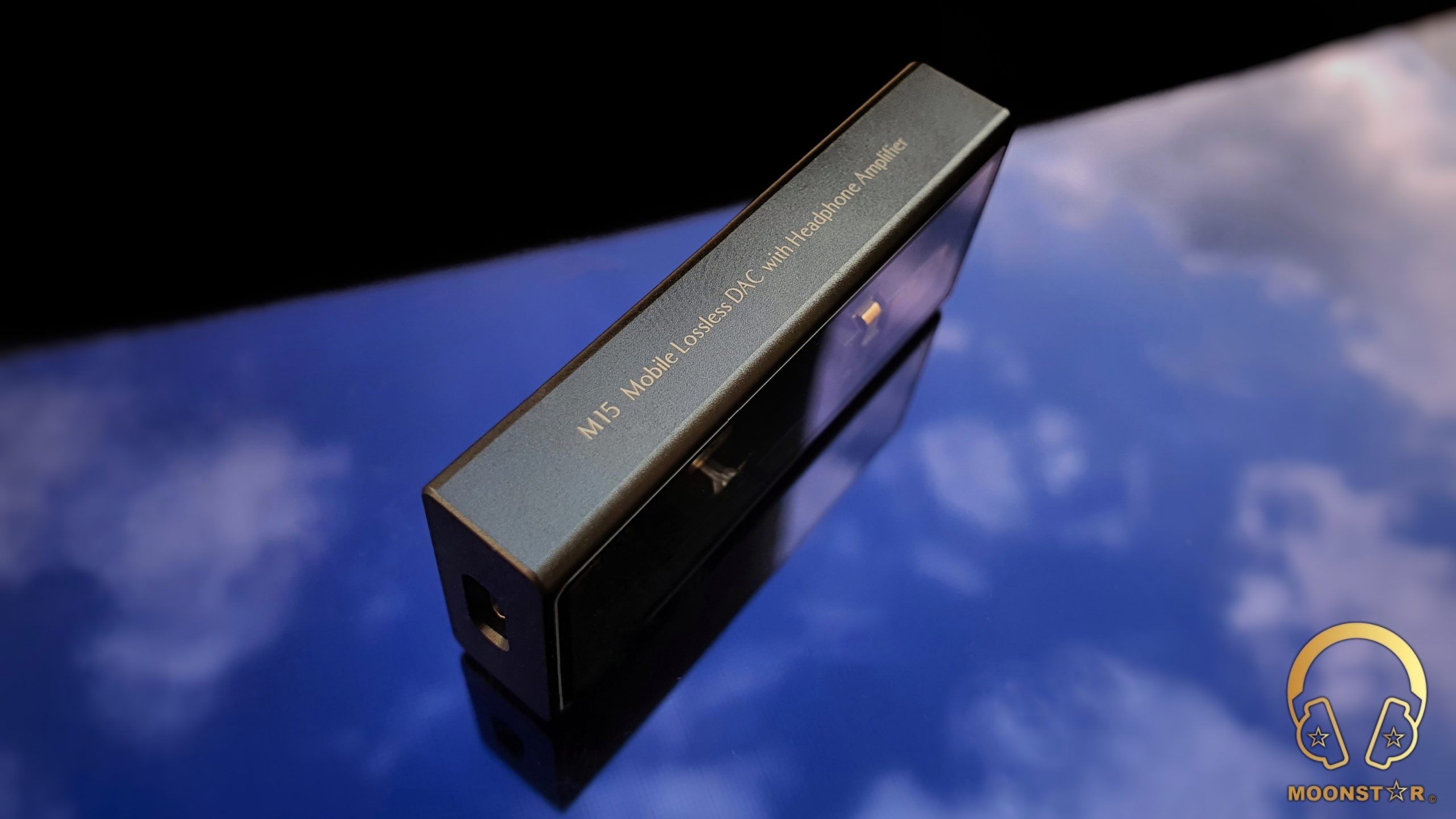
Introduction:
Questyle Audio is a Chinese company that is specialized in research of high-tech lossless audio system such like Desktop Amplifiers (CMA800/CMA800R), DAC/Amplifiers (CMA Twelve, CMA Fifteen, CMA 400i), Wireless Audio Systems, Portable DAC’s (M12) and Audio Players (QPM, QP2R). Questyle has won over 20 international awards since 2015, such as CES Innovation Award, iF Industrial Design Award, and VGP Lifestyle Award, while Foxconn Technology Group is a strategic partner of the company.
The Questyle M15 that I will now review for you is the company’s flagship ultra portable USB DAC/Amplifier that features a ESS ES9281AC DAC Chip, TOREX High-Efficiency Power Management Unit and both 3.5mm Single Ended and 4.4mm Balanced Analog outputs. Moreover, the M15 contains two of Questyle’s patented CMA (Current Mode Amplification) SiP modules, for a total of four CMA AMP engines to driver both Sensitive IEM’s and demanding headphones as well.
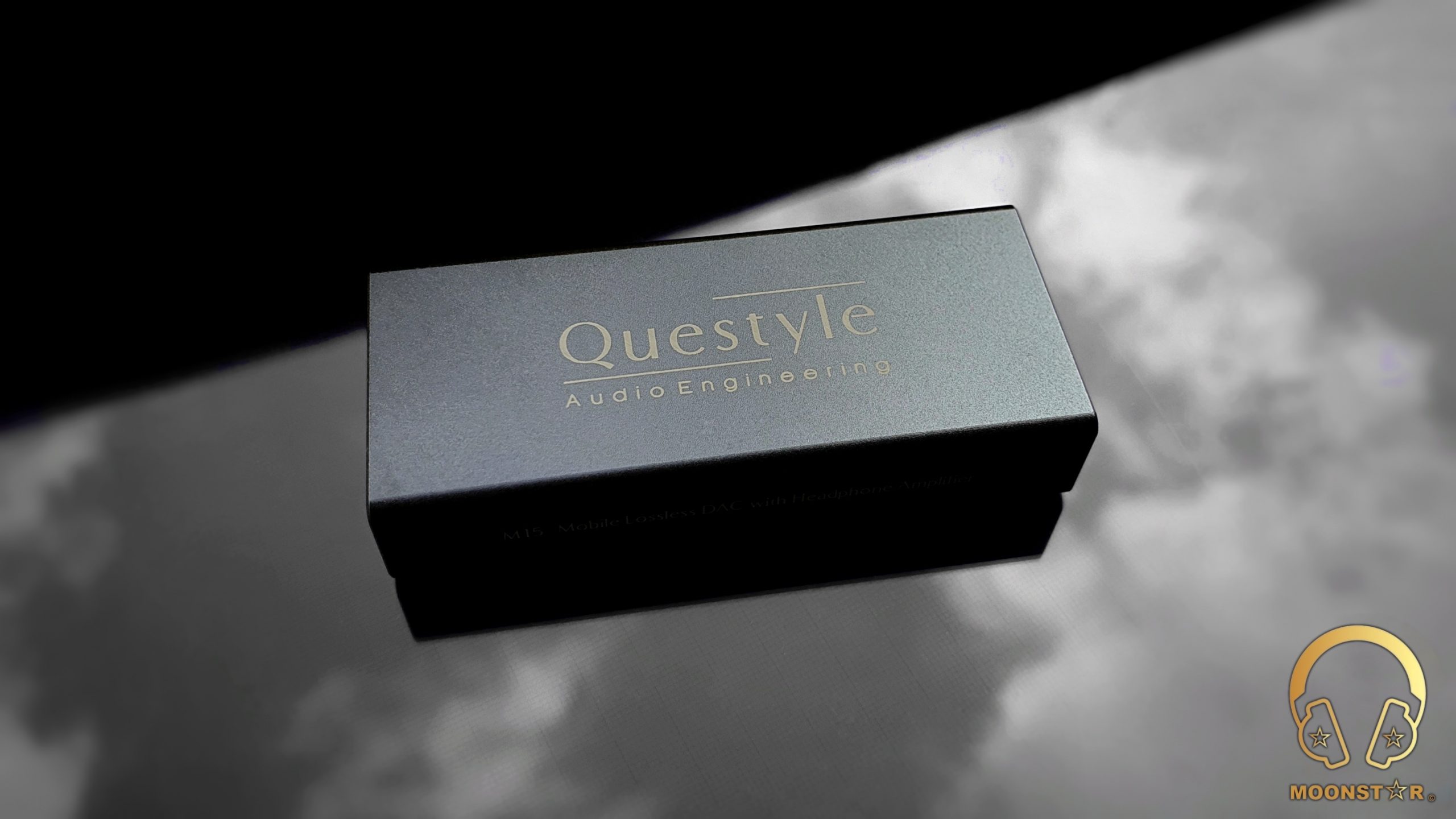
Disclaimer:
I would like to thank Questyle for providing me the M15 Ultra Portable USB DAC/Amplifier as review sample. I am not affiliated with Questyle beyond this review and these words reflect my true and unaltered opinions about the product!
Price & Availability:
The actual MSRP price of the Questyle M15 USB DAC/Amplifier is 249.00 US$. More information’s can be found under the link below;
Package and Accessories:
The Questyle M15 came in a relative small rectangular back cardboard box with a premium look and feel that sports some product related brandings o the top and specifications at the bottom.
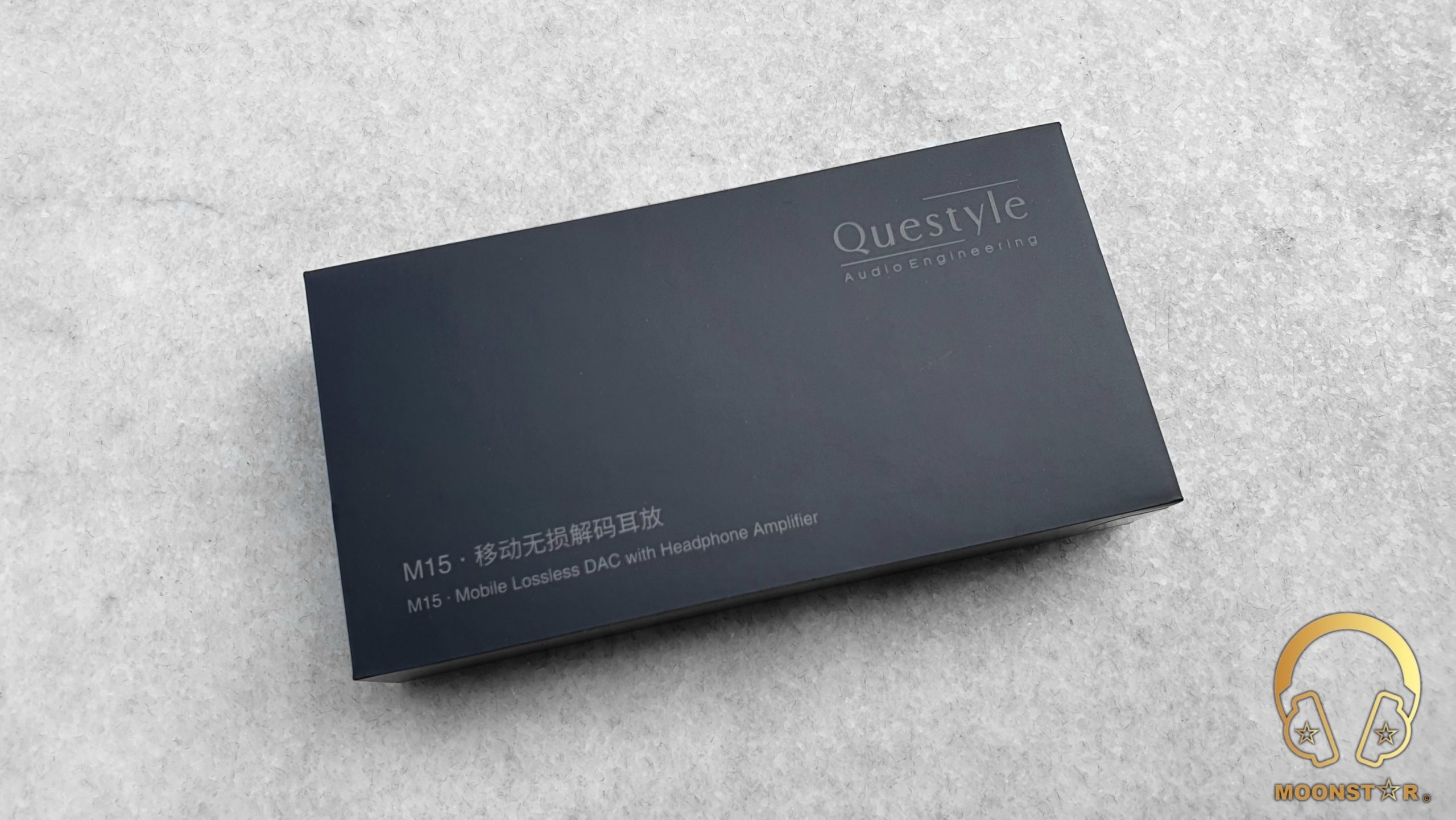
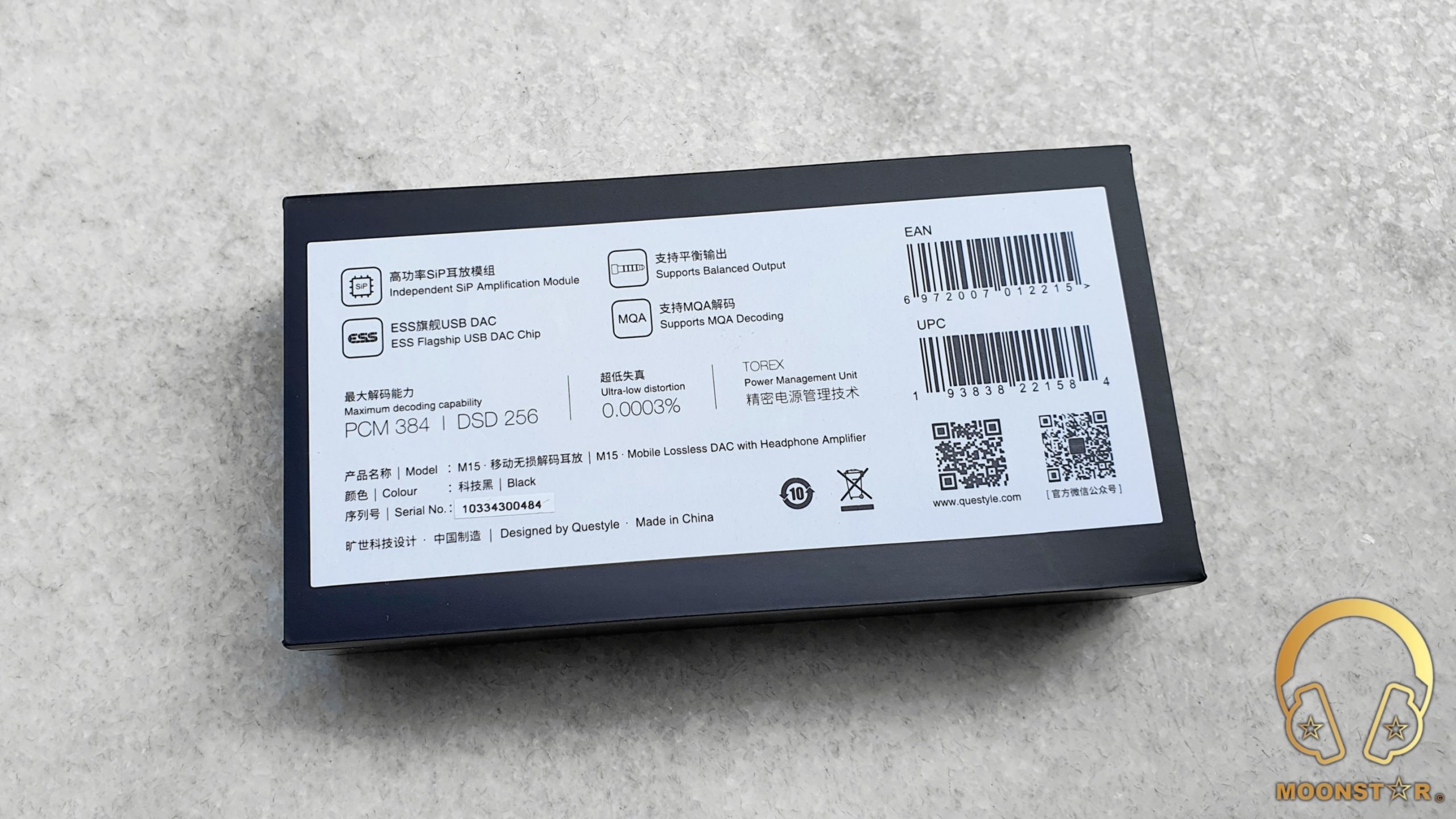
Inside the box are the following contents & accessories;
- 1 x Questyle M15 Ultra Portable USB DAC/Amplifier
- 1 x USB Type-C to USB Type-C Low Profile Cable
- 1 x USB Type-A to USB Type-C Low Profile Cable
- 1 x Print Material (Instruction Manual & Guarantee Card)
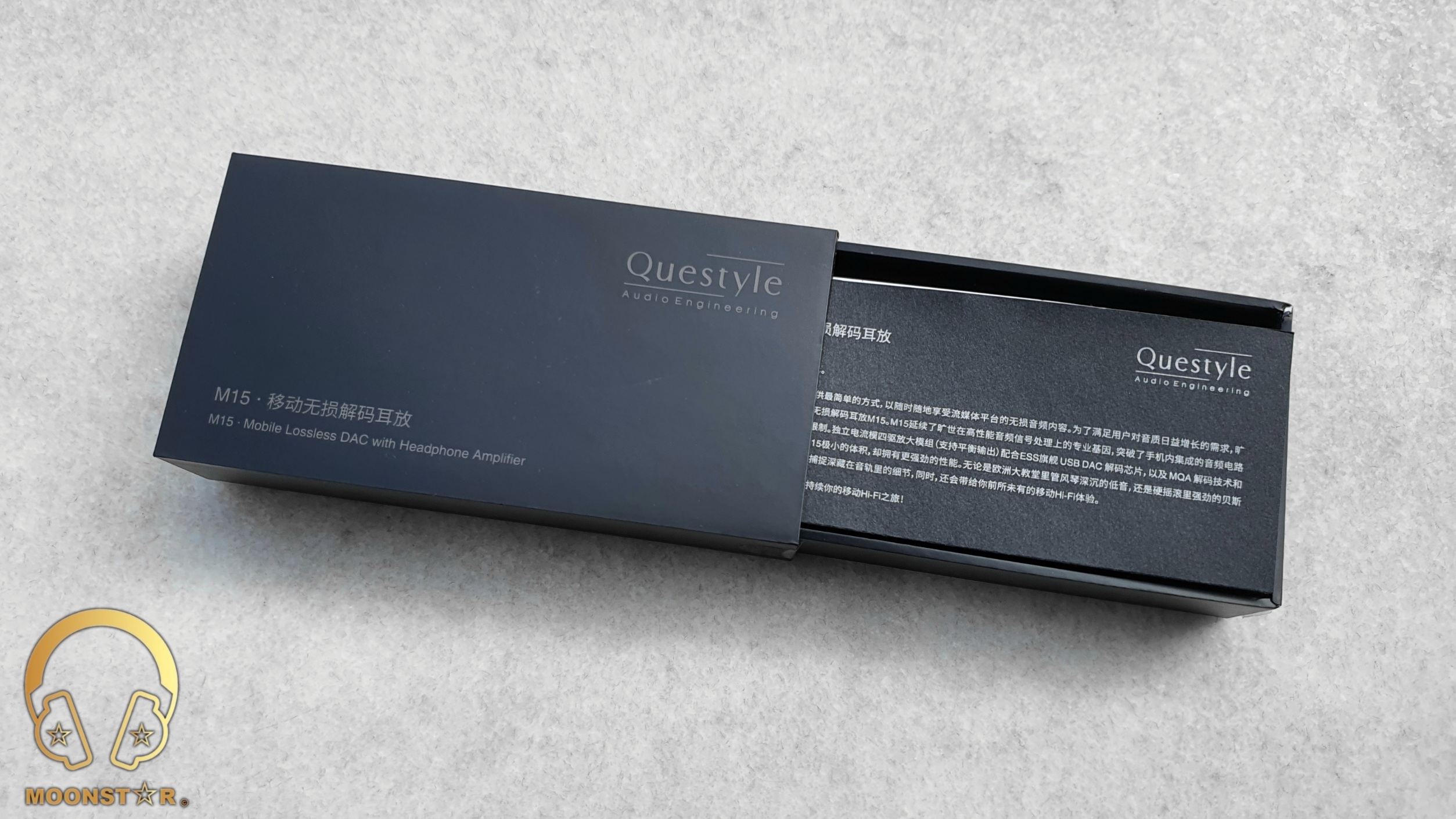
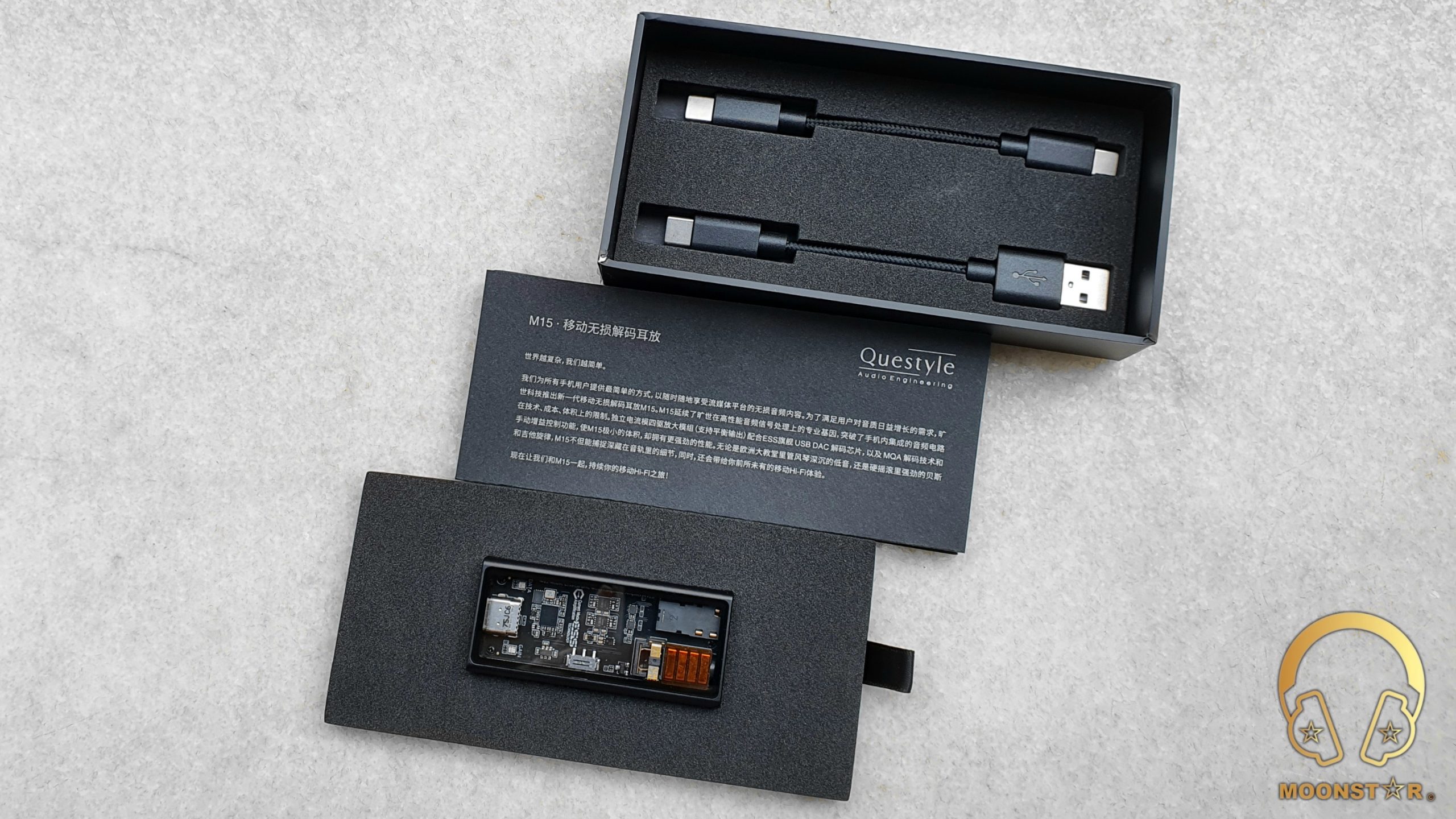
The M15 has a premium looking leather case available in 3 different colour options that is sold separately for 30.00 US$. The good news is that you can get now for FREE for as Launch Gift for a limited time (till 15th of May).
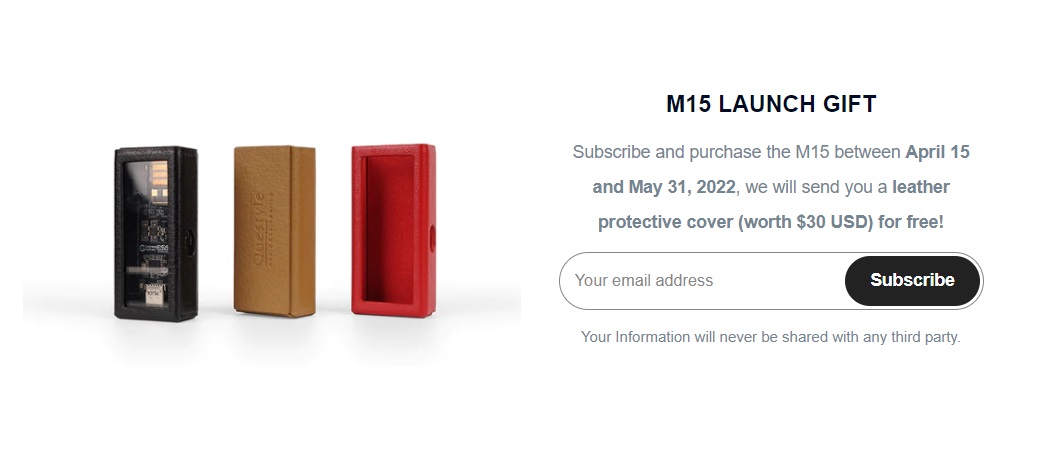
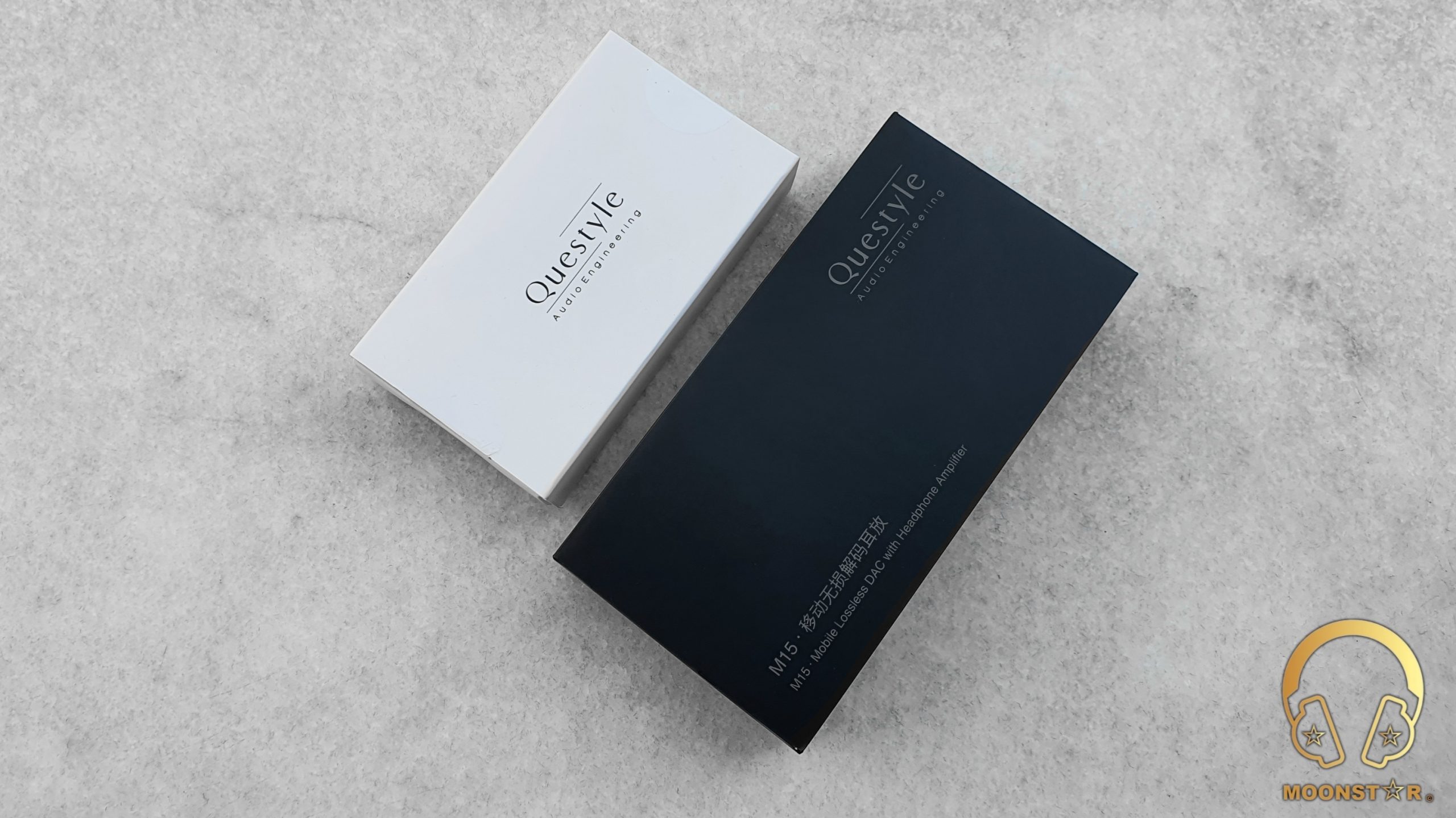
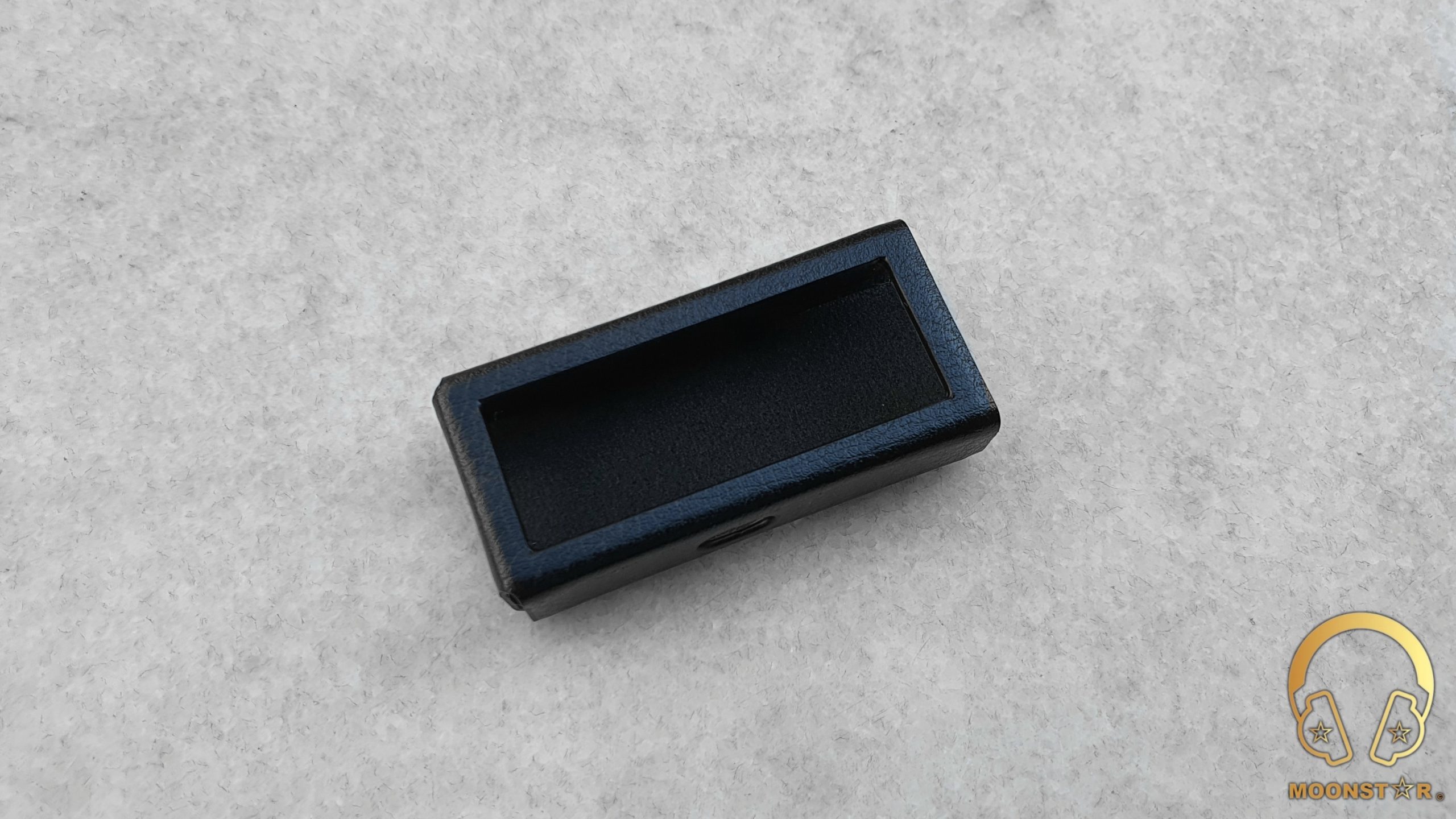
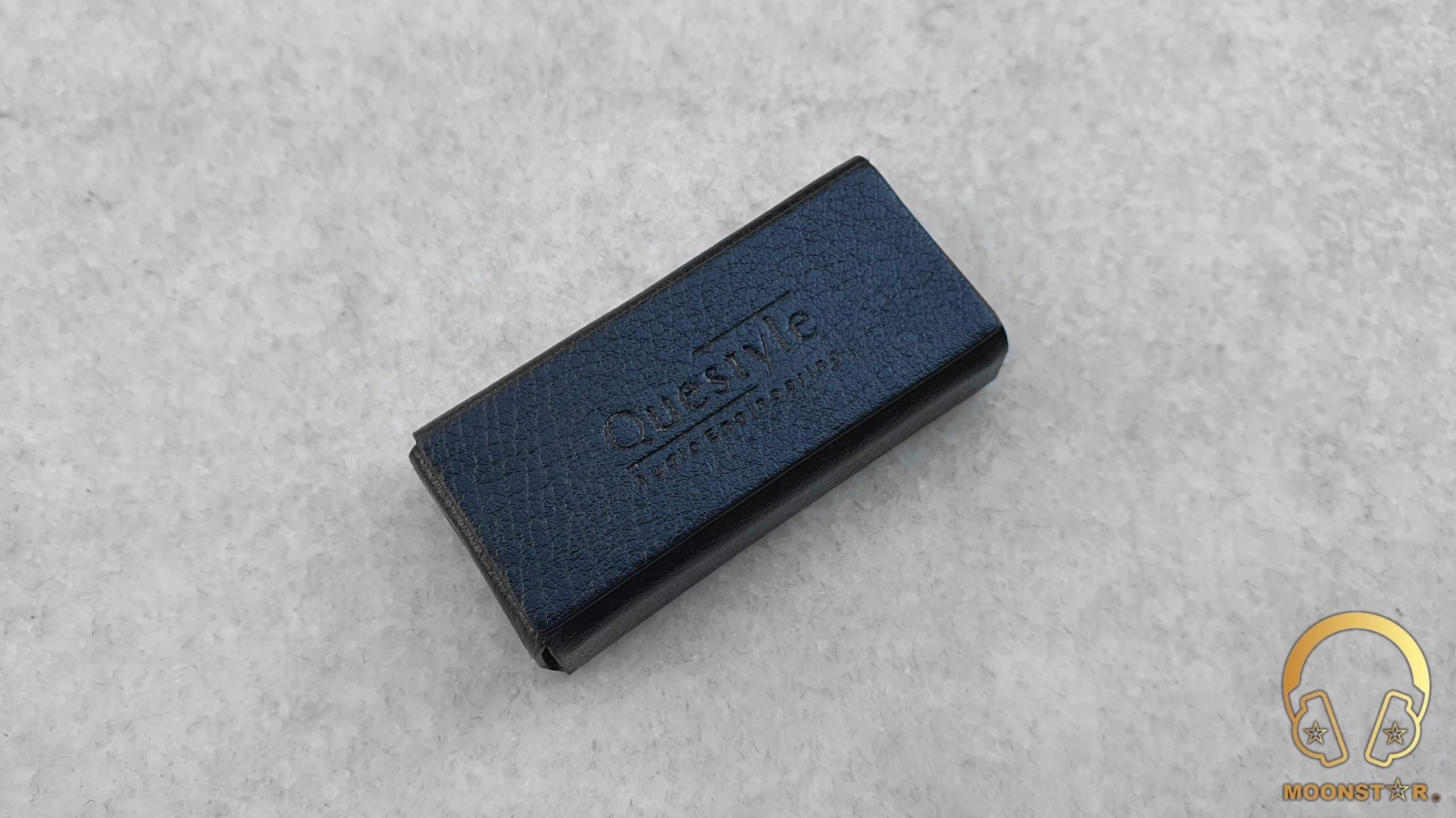
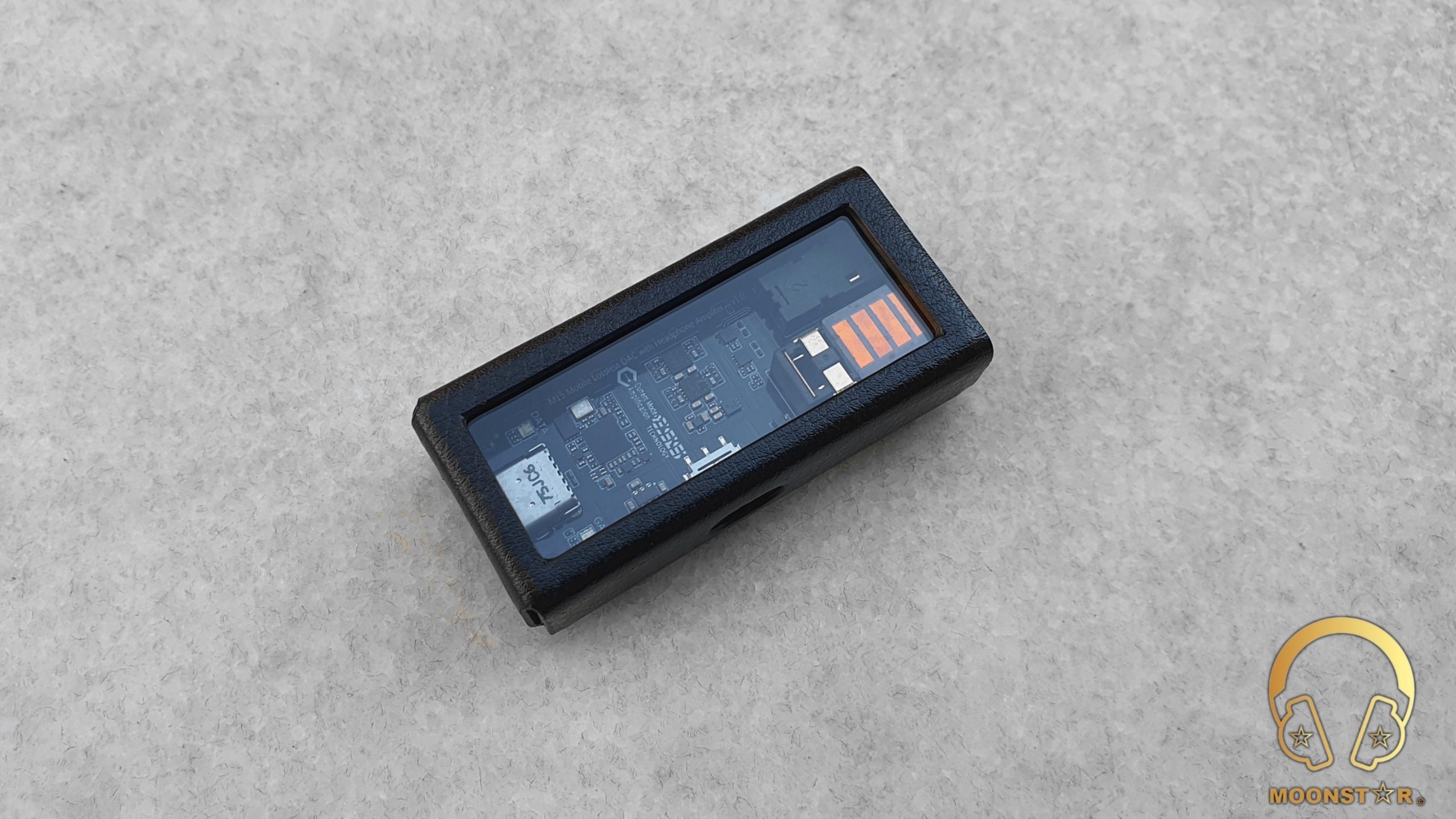
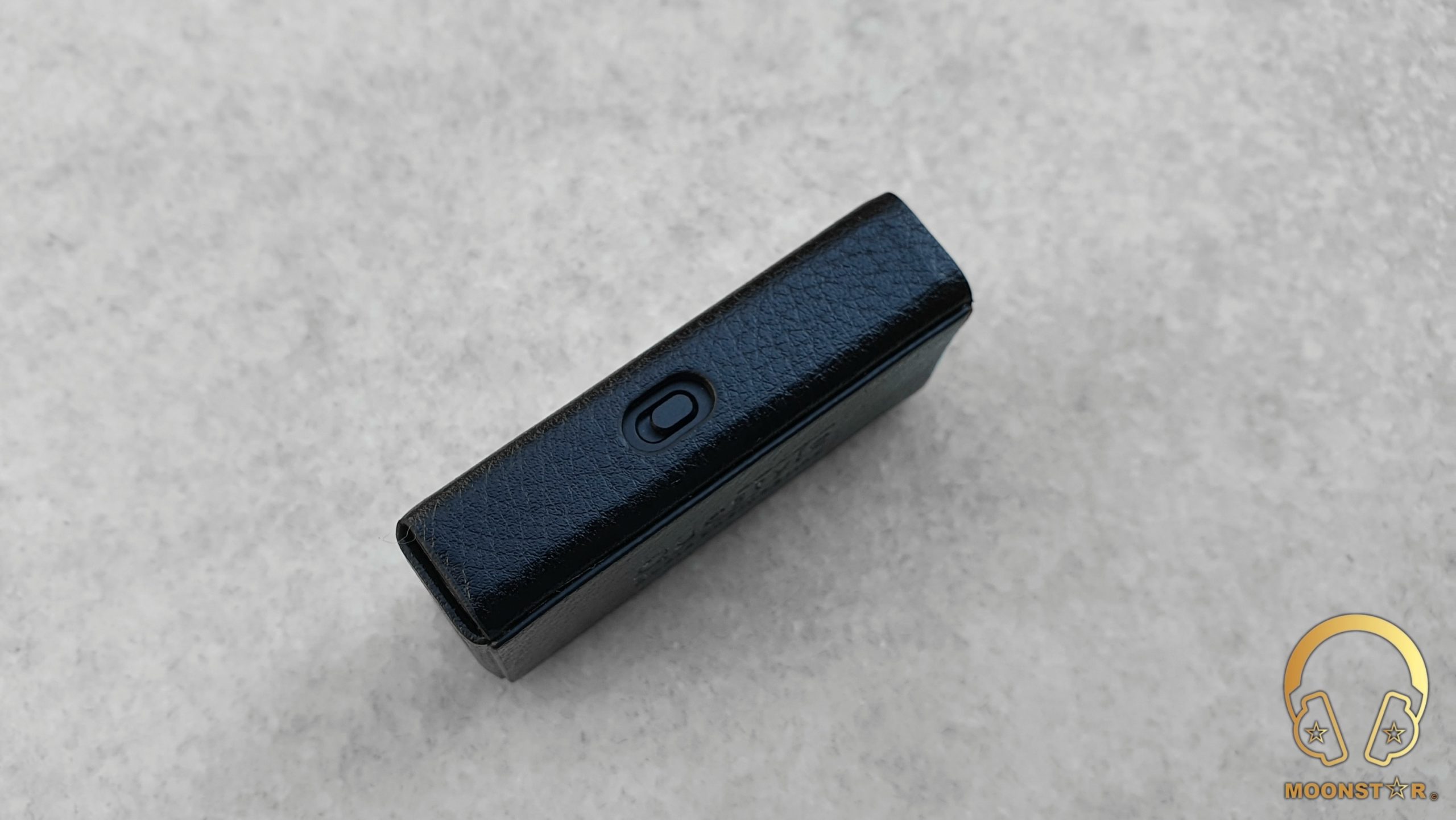
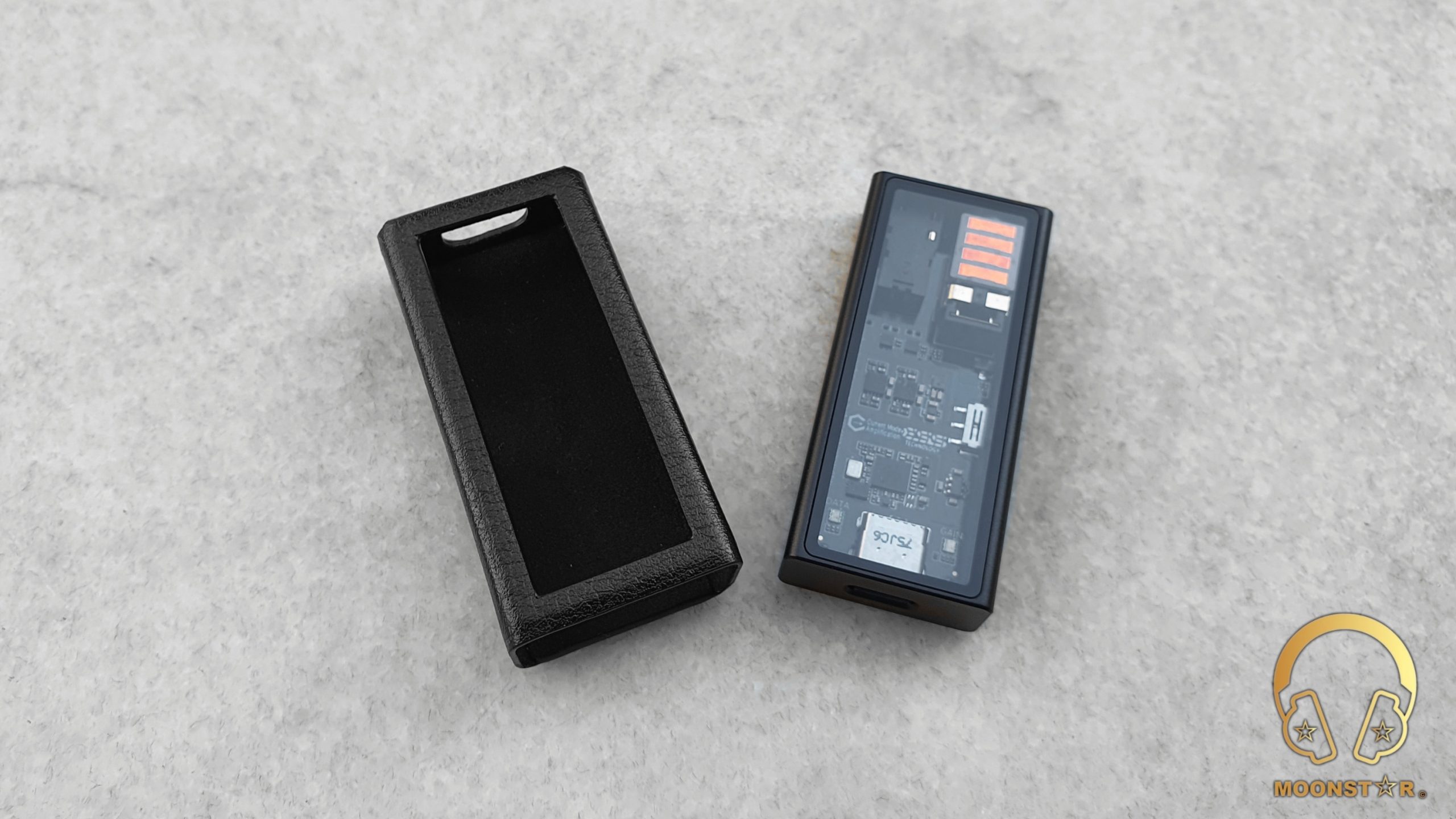
Design & Build Quality:
The Questyle M15 is an amazing looking USB DAC/Amplifier that offers a unique visual experience with its CNC machined aluminium housing with a transparent top cover, which feels very premium and robust when you hold it in your hands.
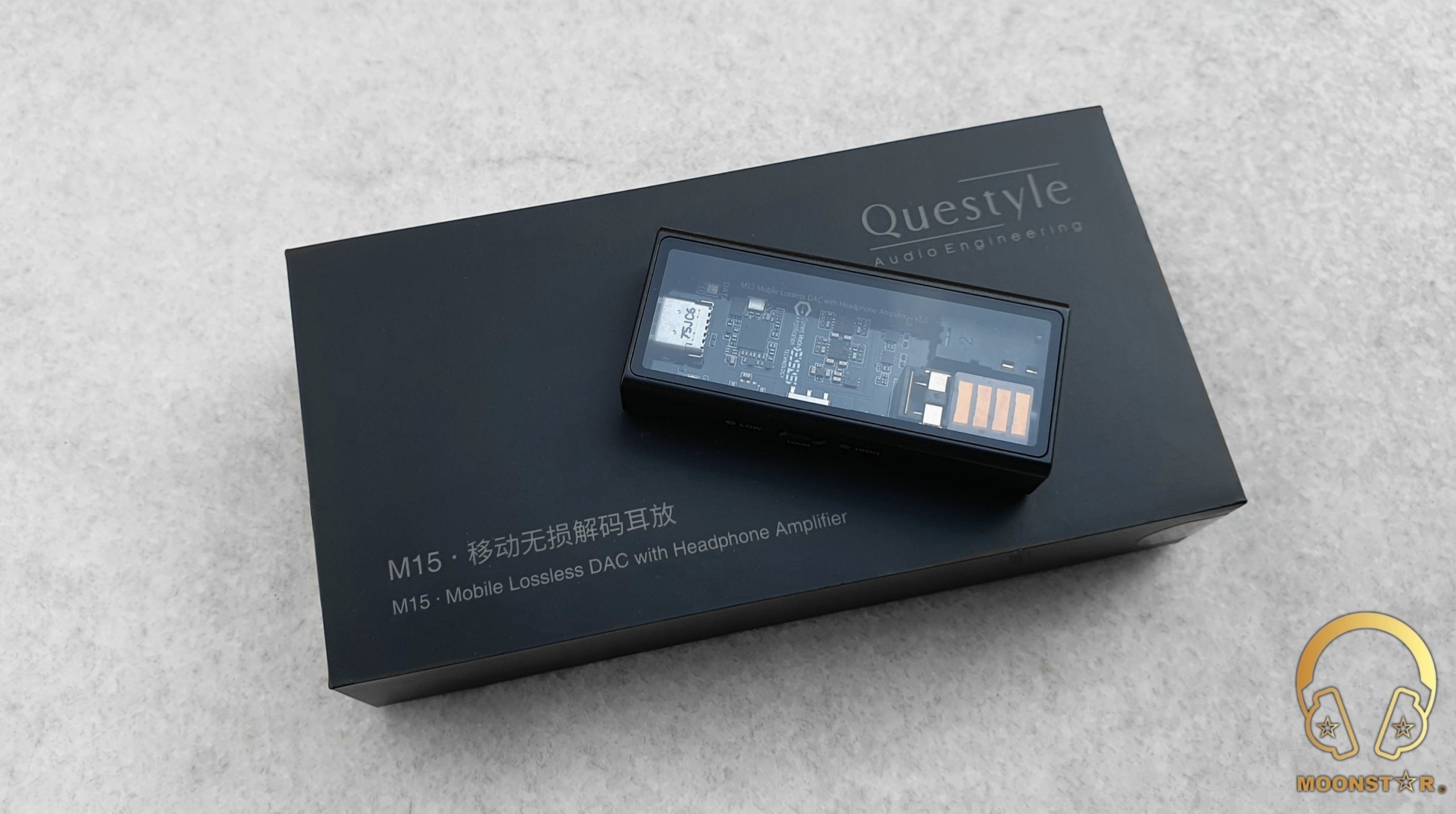
The M15 is an Ultra Portable USB DAC/Amplifier with dimension of approx. 61.8[L] X 27.2[W] X 12[D]mm without the low profile cables that are included inside the package.
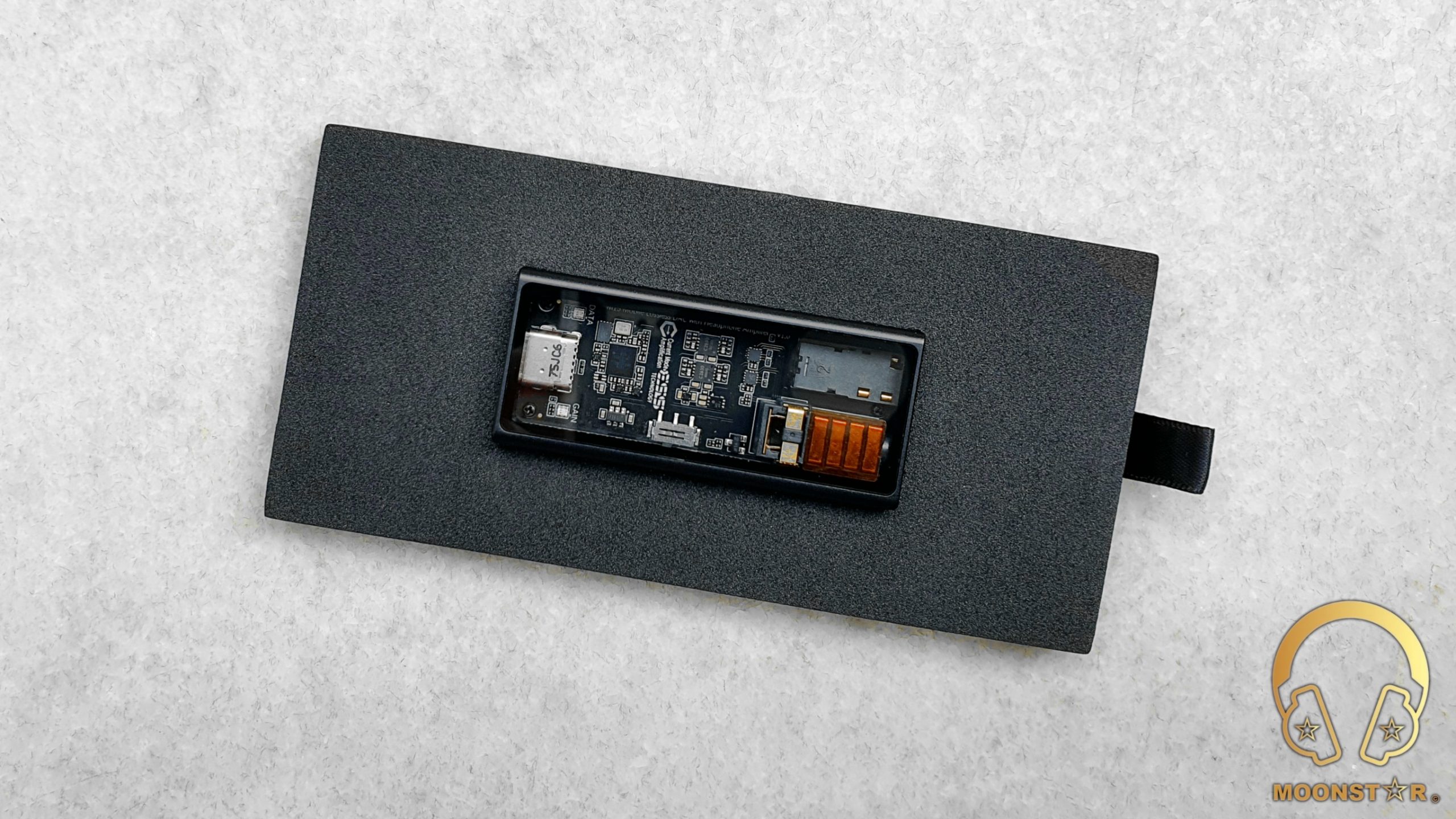
The main body that is made from CNC Machined Aluminium alloy material is in black colour and shows a rectangular shape with slightly rounded edges.
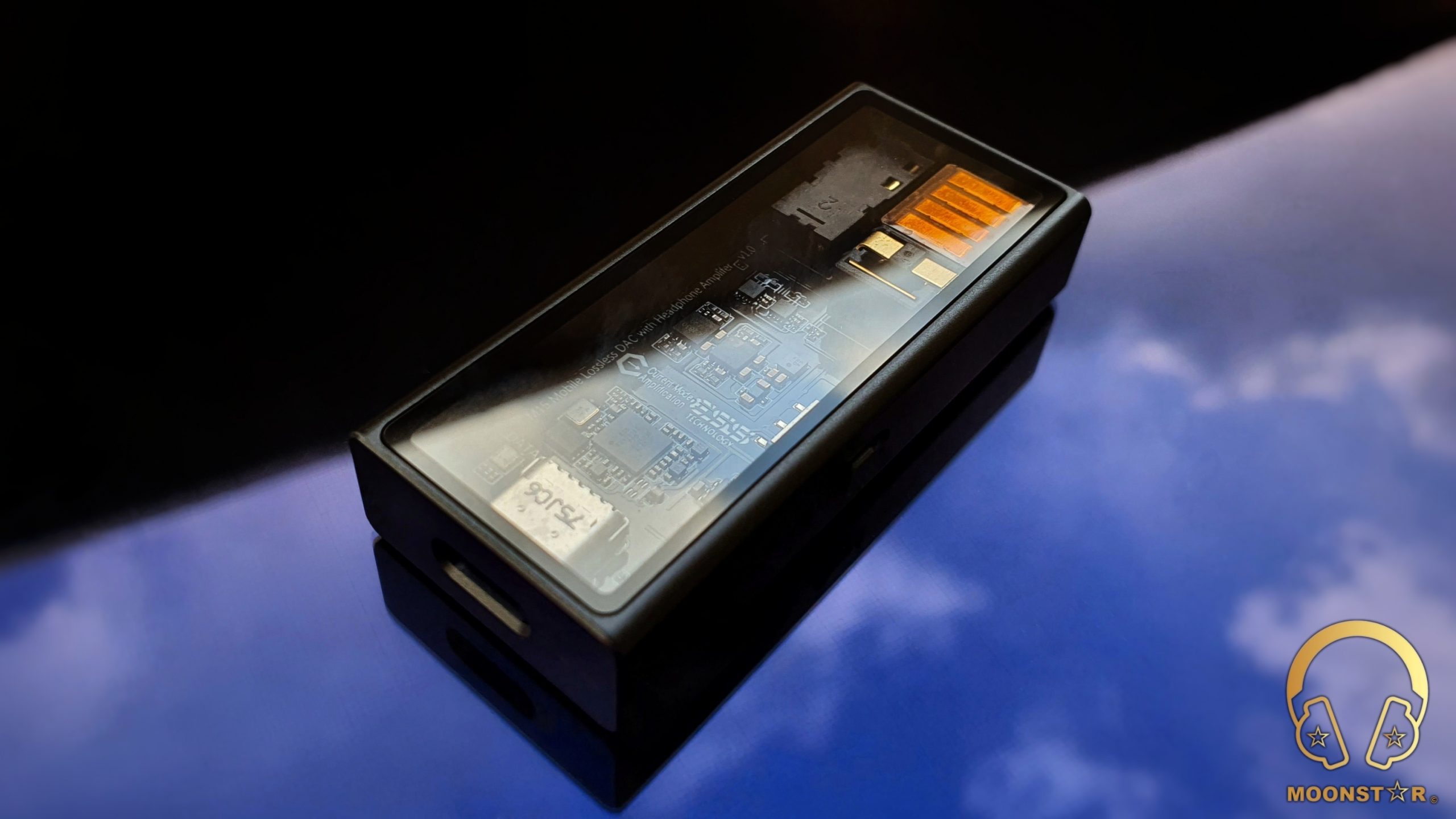
At the left surface of the M15 is the Low & High hardware switch that I do prefer over software controlled gain options.
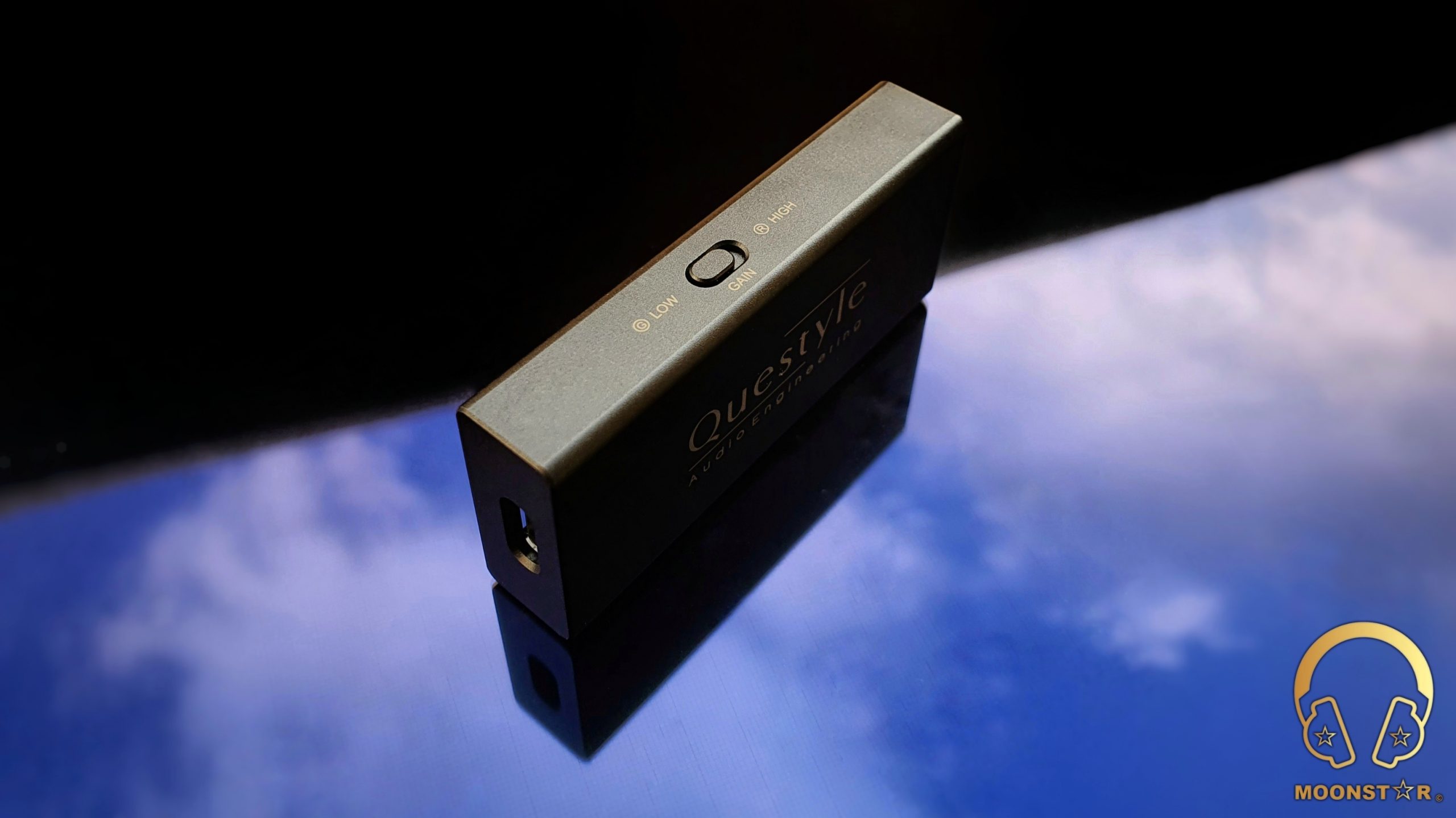
At the right surface of the device is the “M15 Mobile Lossless DAC with Headphone Amplifier” branding.

On the top of the M15 is a transparent top cover that makes it possible to see the PCB layout with all the hardware components like the ESS ES9281AC DAC Chip, TOREX Power Management Unit, SiP Current Mode Amplification modules, 4.4mm Balanced and 3.5mm Single Ended output and more, which offer visually attractive experience.
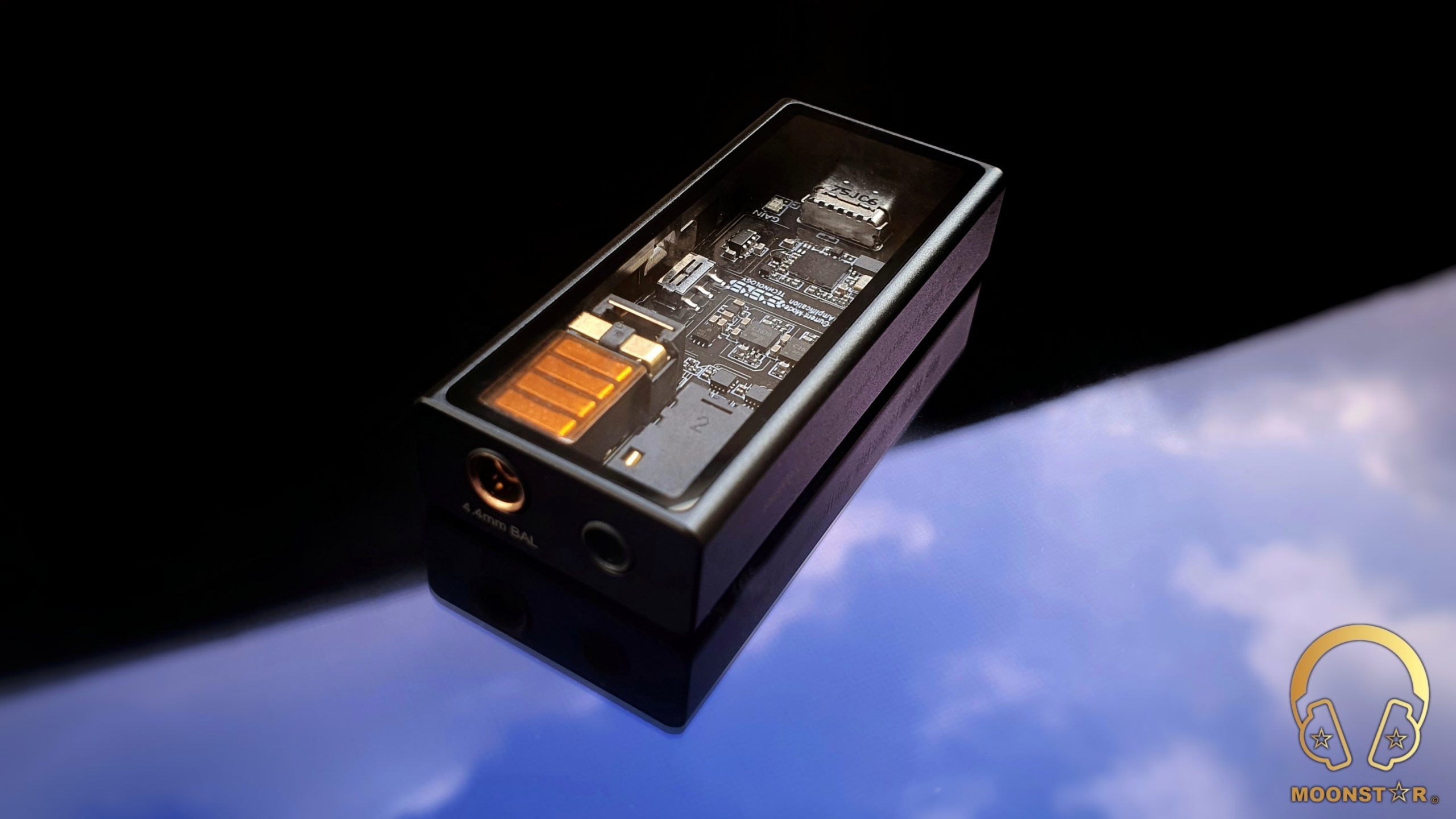
Here are also two LED light indicators, one is dedicated for the gain status (red & green) and the other one is the Data Indicator that gives information about the actual payed format.
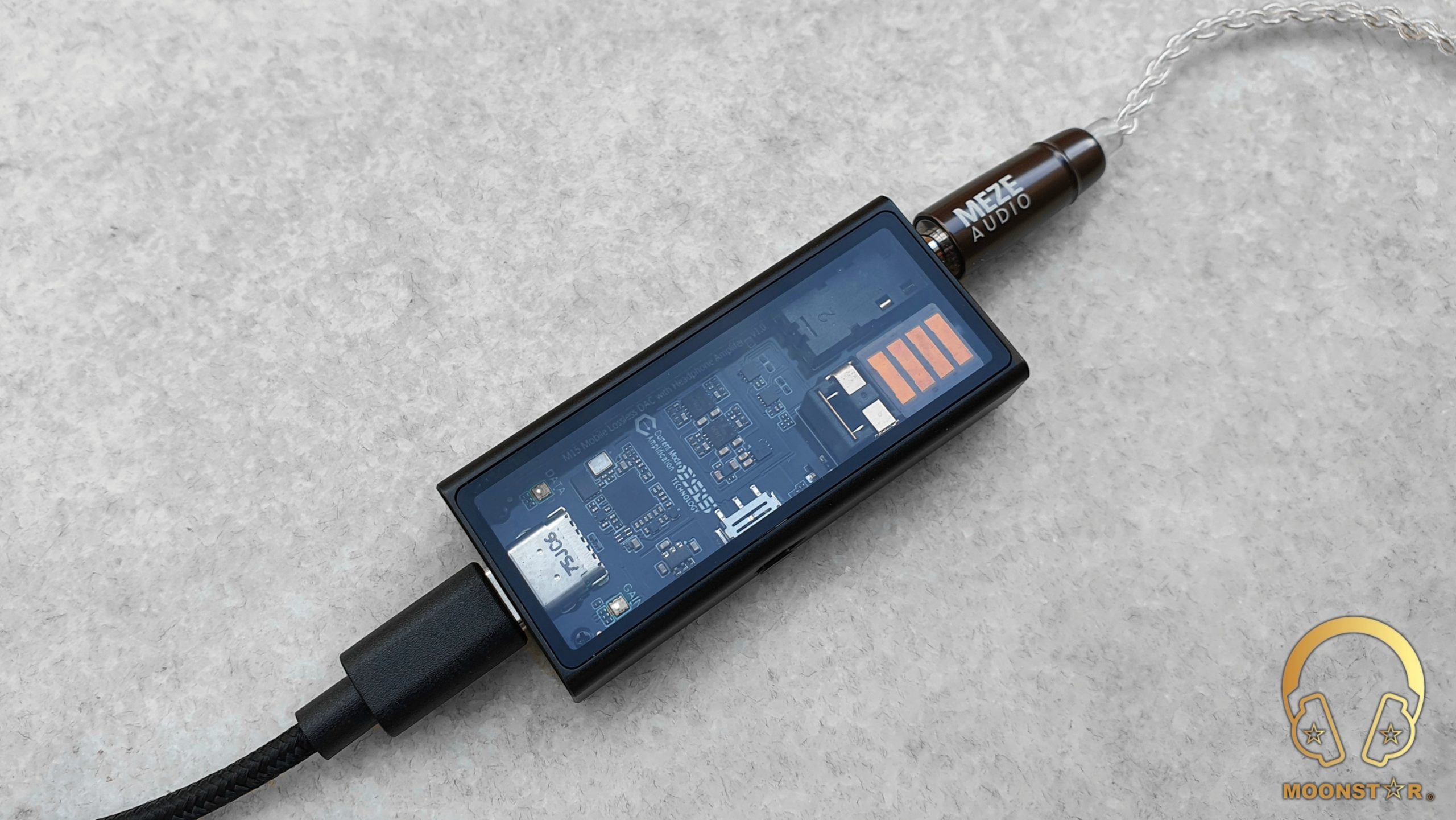
On the top of the device are both the 3.5mm Single Ended (with CTIA support for headphones featuring phone calls) and the 4.4mm Balanced (TRRRS “Pentaconn”) headphone outputs that do offer a tight and sturdy connection.
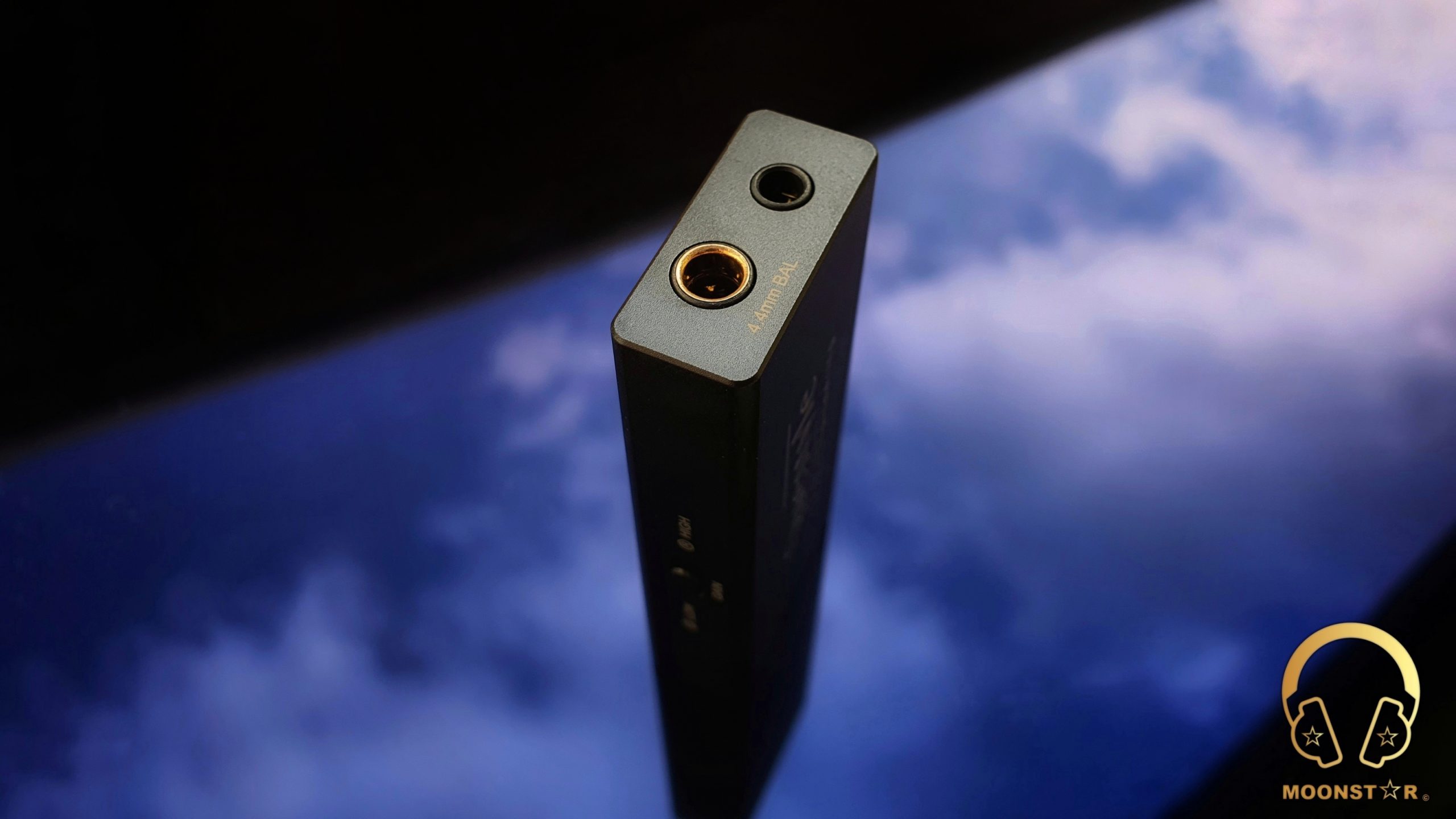
The rear surface of the M15 ultra-portable USB DAC/Amplifier features the Questyle logo/branding.
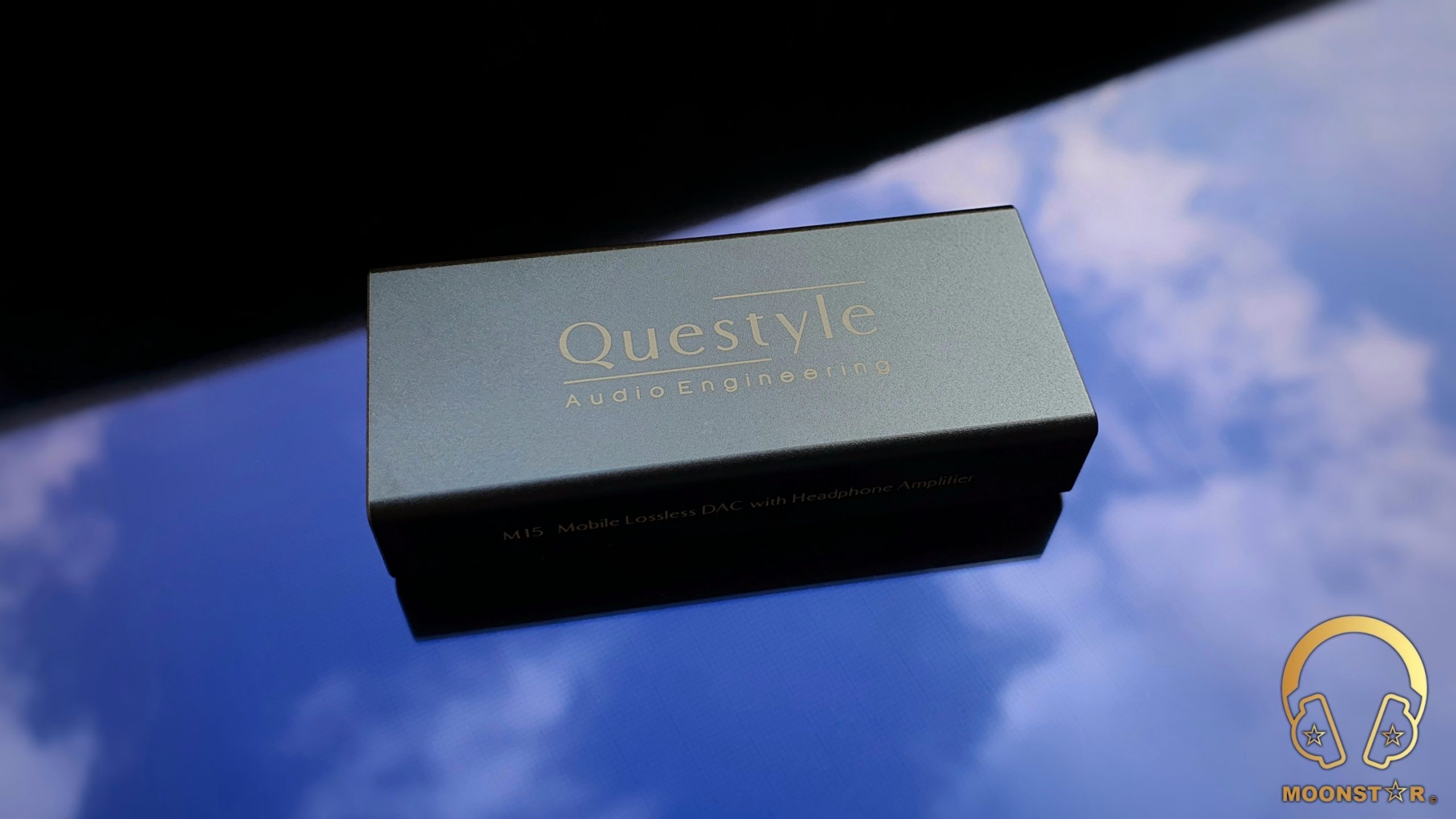
On the top of the device is the USB Type-C DATA port that is dedicated for the digital data transfer.
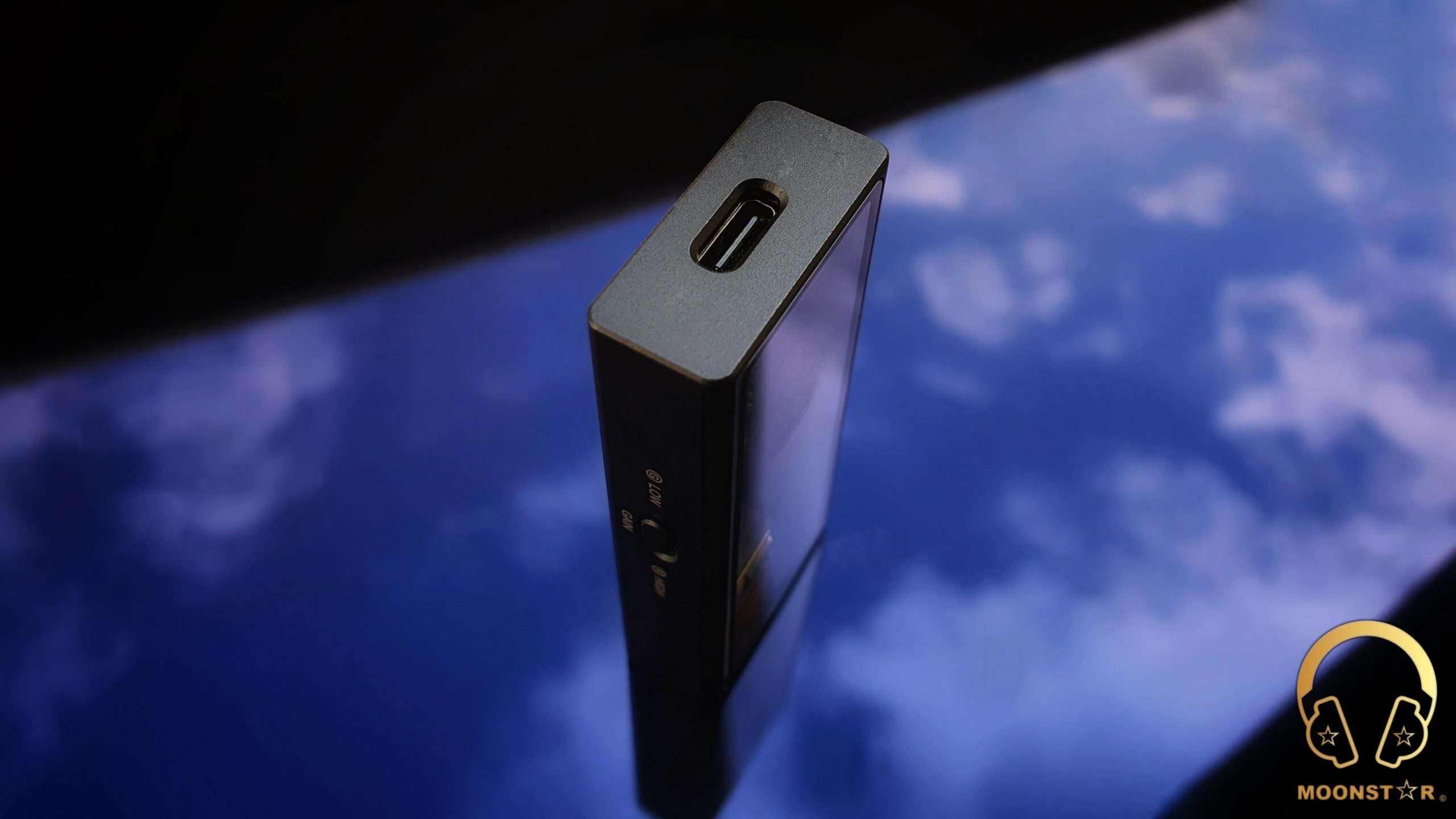
The overall build quality of the Questyle M15 and the cables is of high quality that fulfils my expectations from an audio gear at this price level.
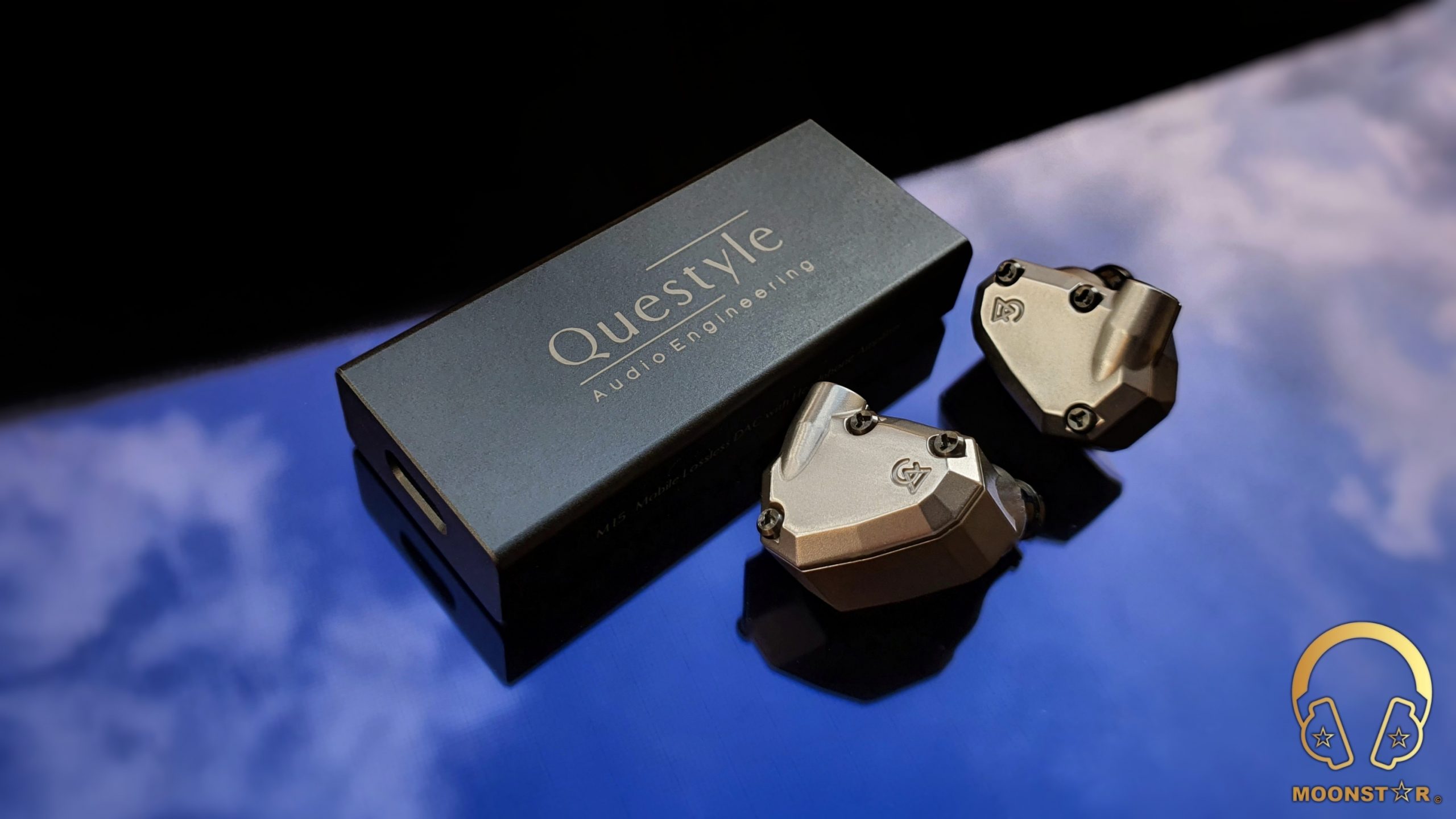
Technical Specifications:
- DAC chip : ESS ES9281AC
- Frequency Response : ±0.1dB (20Hz-20kHz)
- THD+N : 0.0003%
- SNR : -130dB
- Output power : 3.5mm: 11.97mW @300Ω, 4.4mm: 22.60mW @ 300Ω
- PCM : up to 384kHz (16/24/32Bit)
- DSD : up to Native DSD256 (1Bit 11.2MHz)
- Dimension : 61.8[L] x 27.2[W] x12[D] mm
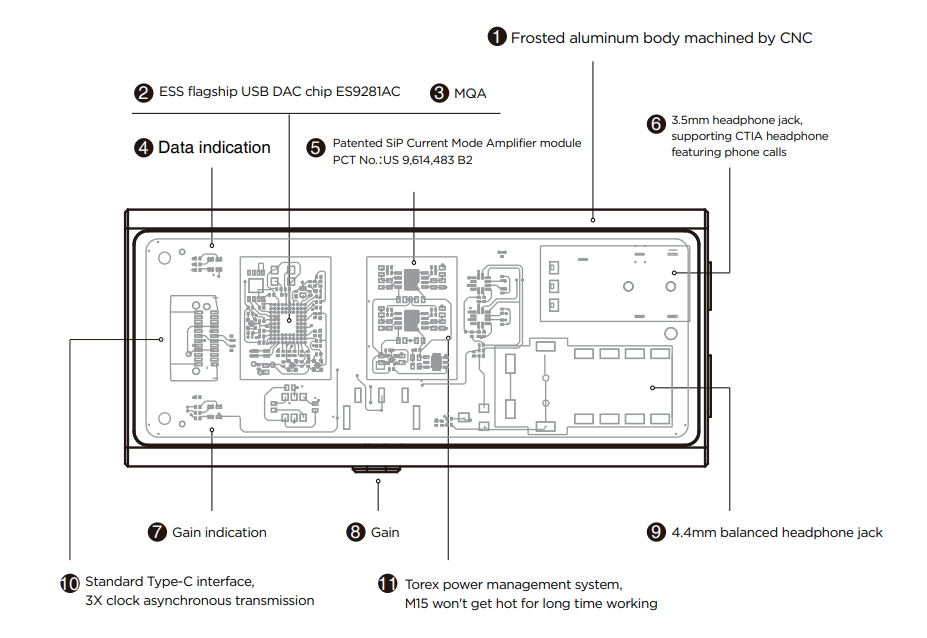
Hardware & Software Features:
The Questyle M15 is an Ultra-Portable USB DAC/Amplifier that offers some impressive hardware specs such like the ESS ES9281AC DAC Chip, TOREX High-Efficiency Power Management Unit and two of Questyle’s patented CMA (Current Mode Amplification) SiP modules.
A) DAC (Digital to Analog Converter):
The M15 features ESS Technologies ES9281AC flagship DAC Chip, which is a feature rich 32bit 2-Channel Digital to Analog Converter that utilizes the critical acclaimed ESS patented HyperStream II architecture. The device offers an impressive SNR (Signal to Noise Ratio) of -130dB and a decent THD+N (Total Harmonic Distortion) of only 0.0003%.
The Questyle M15 support sampling rates from 16, 24, 32Bit, 44.1, 48, 88.2, 96, 176.4, 192, 352.8, 384kHz and up to Native DSD 256 (1Bit 11.2MHz).
The LED Indicator that is visible under the transparent front panel of the M15 gives information’s about the data status, which are list below;
- Green: Sample rate is 48kHz or less.
- Red: Hi-RES lossless files up to PCM 88.2kHz~384 kHz & Native DSD64~DSD256.
- Magenta: The M15 is performing the final unfold of an MQA Core stream.

B) Connectivity:
Inside the box are two low profile USB cables, one USB Type-C to USB Type-C and one Type-A to USB Type-C cable to connect the M15 to your Digital Music source.
Devices offers a plug and play function that supports Android 5.0 and above, Apple iOS devices such like iPhone and iPad, Windows PC’s with Win10 1803 and above, and Apple computer with MAC OS.
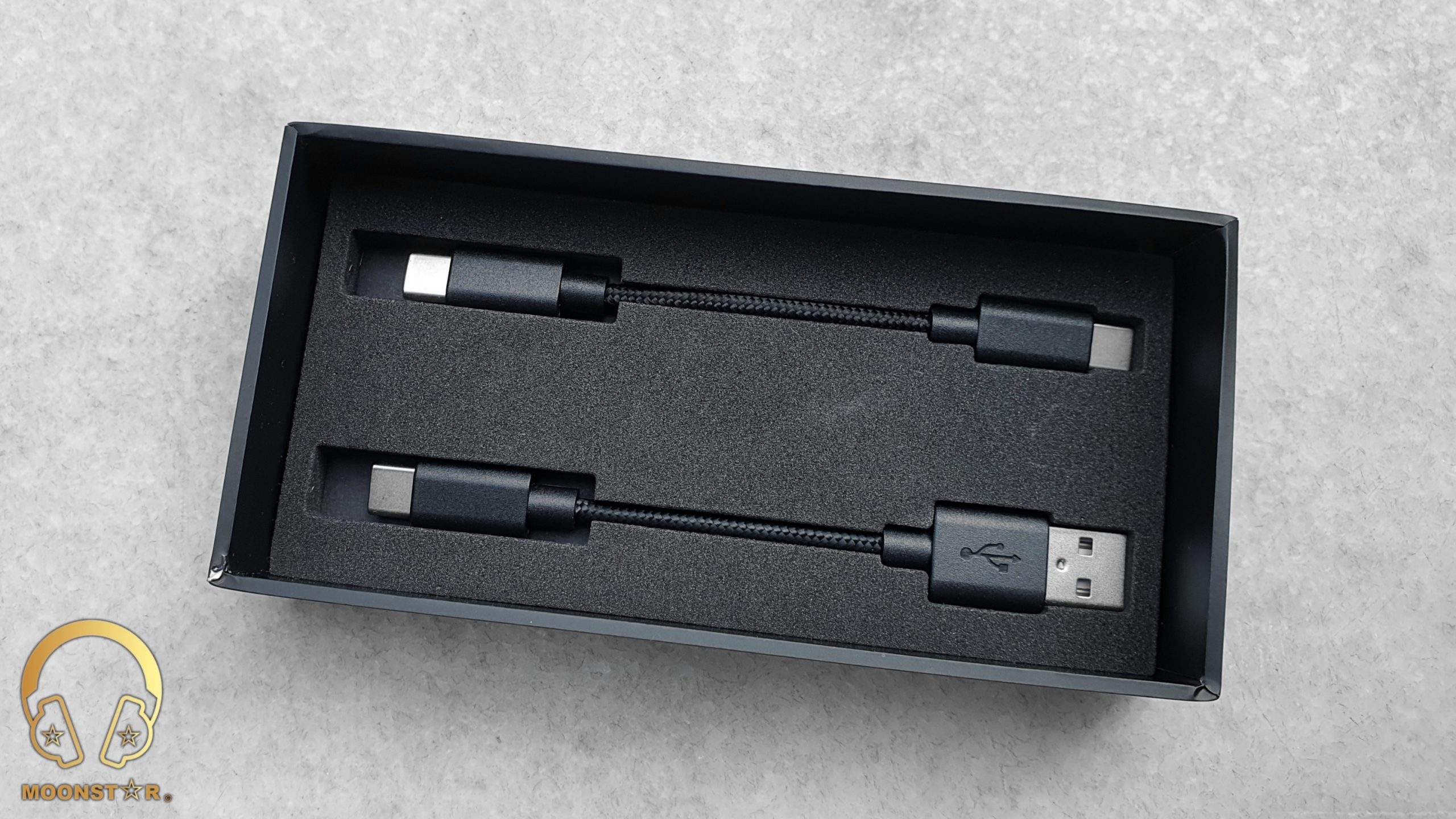
C) Amplification & Background Noise:
The Questyle M15 is a very powerful device especially for an Ultra-Portable USB DAC/Amplifier thanks to the use of its patented SiP modules, for a total of four CMA AMP engines. This quadruple drive amplification circuitry gives enough out power to drive even high demanding planar headphones such like the HiFiMAN Sundara or SIVGA P-II.
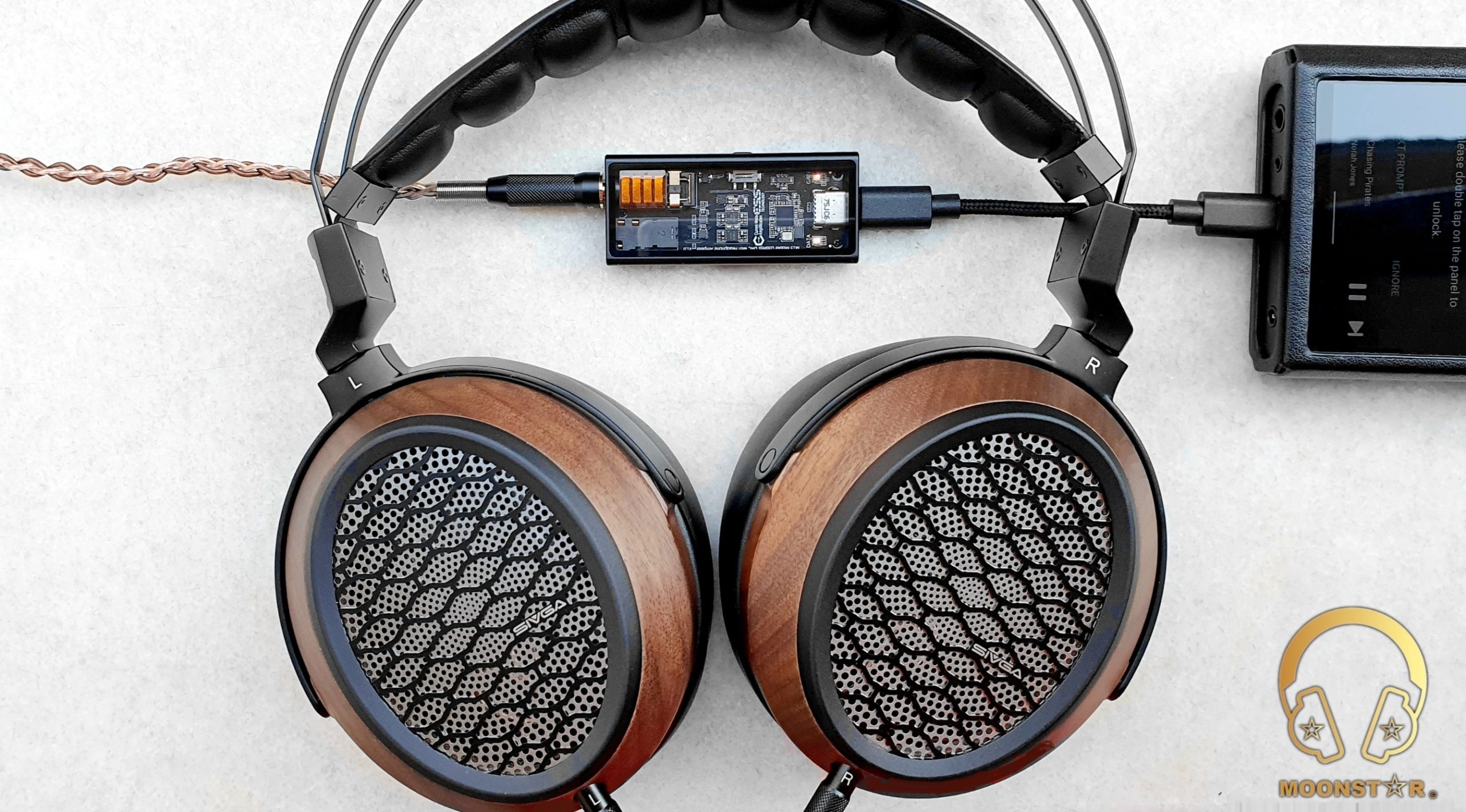
Questyle’s Current Mode Amplifiers are characterized by their small footprint, low voltage operation, and minimal power consumption. Current Mode amplification offers also a low impedance (according to Questyle that is not listed on their specs), a bandwidth up to 1MHz and a Total Harmonic Distortion of 0.0003%.
Here are some Technical specs about the output power of the Questyle M15:
- 3.5mm: RL=300Ω, Po=11.97mW, Vout (Max) = 1.895Vrms, THD+N=0.00045%
- 4.4mm: RL=300Ω, Po=22.60mW, Vout (Max) = 2.624Vrms, THD+N=0.00057%
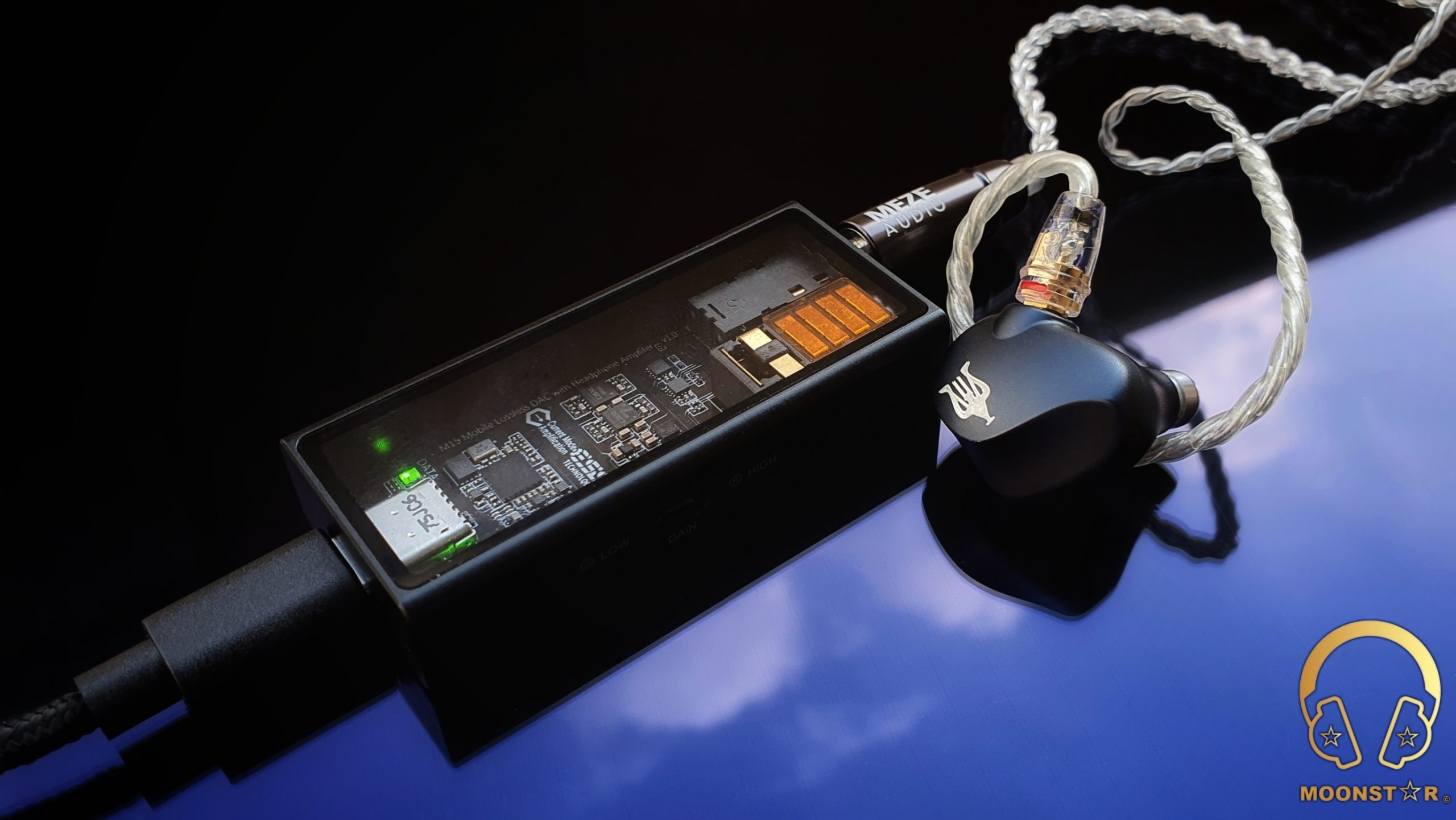
D) Power Consumption & Overheating Performance:
The Questyle M15 is equipped with the TOREX High-Efficiency Power Management Unit to archive a relative low power consumption to increase the battery life of your source, which was quite decent compared to other USB DAC/Amplifiers that I have used before, especially with such a powerful amplification capability.
What I also found quite impressive is the that the Questyle M15 doesn’t overheats after long listening periods, even while powering some of my high demanding full sized open-back planar headphones such like HiFiMAN Sundara or SIVGA P-II.
Equipment’s used for this review:
- DAC/Amplifiers : Questyle M15, Cayin RU6, Shanling UA5
- USB Source : Samsung Galaxy Note10 Plus, Asus TUF FX505DU
- IEM’s : Meze Audio RAI Penta, Campfire Audio ARA, Kinera URD
- Headphones : SIVGA P-II, HiFiMAN Edition XS, HiFiMAN Sunadra
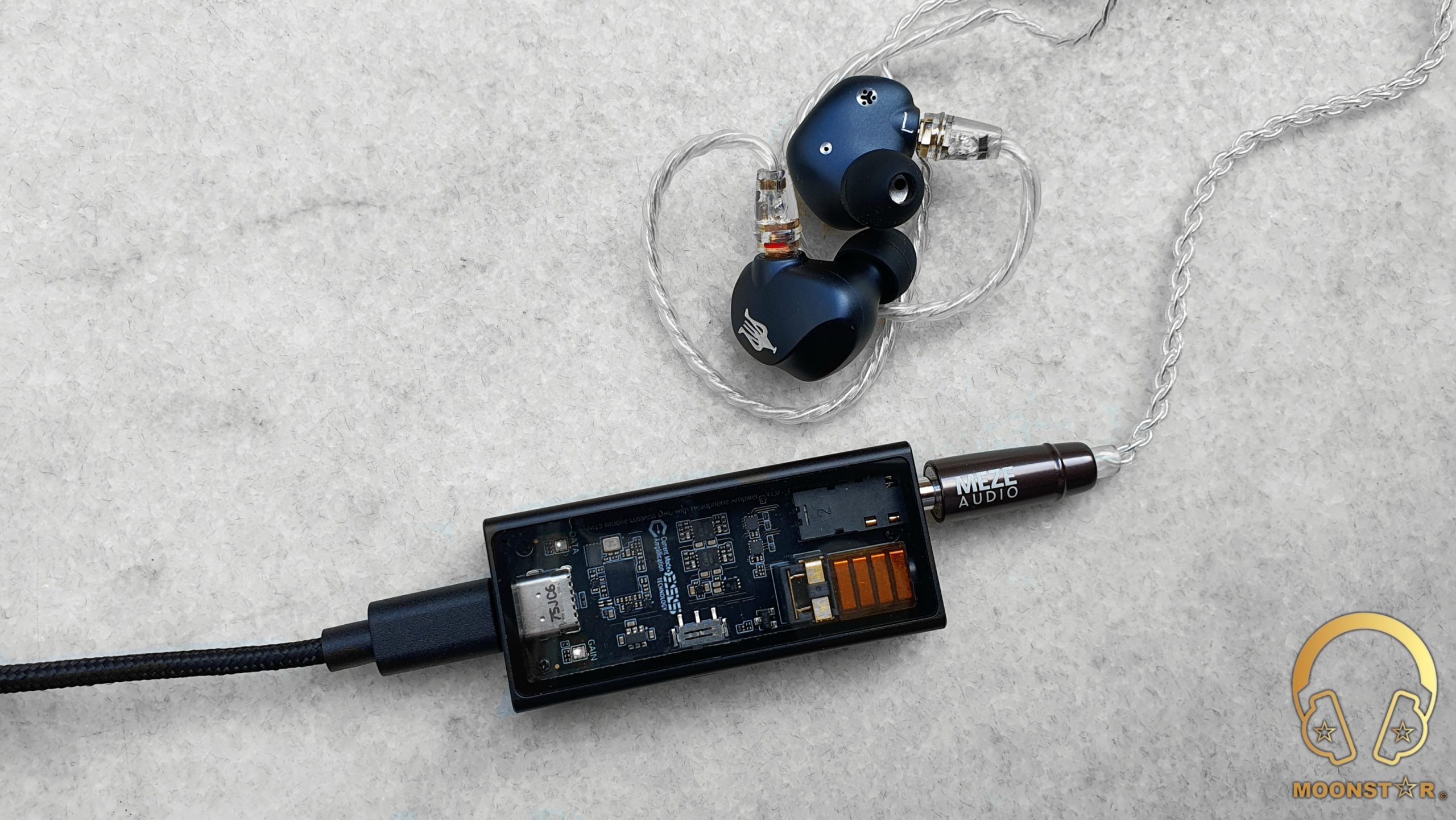
Albums & tracks used for this review:
- Adele – My Little Love (Spotify)
- Randy Crawford – On Day I Will Fly Away (Flac 16bit/44.1kHz)
- Hayley Westenra – Odyssey Album (Dezzer HiFi)
- Dionne Warwick – Walk On By (Flac 16bit/44.1kHz)
- Sarah McLachlan – Angel (Flac 24bit/48kHz)
- Sertap Erener – Aşk (Flac 16bit/44.1kHz)
- Sonya Yoncheva – (Giuseppe Verdi) II Trovatore, ActI (Flac 24bit/44kHz)
- Edith Piaf – Non Je Ne Regrette Rien (Flac 16bit/44.1kHz)
- Diana Krall – So Wonderful (DSF)
- Aretha Franklin – I Say A Little Payer (Flac 24bit/96kHz)
- David Bowie – Heroes (Flac 24bit/192kHz)
- Elton John – Rocket Man ((Flac 24bit/96kHz)
- Barry White – Just The Way You Are (Flac 24bit/48kHz)
- Isaac Hayes – Walk On By (Flac 16bit/44.1kHz)
- Sting – Englishman in New York – (Flac 24bit/48kHz)
- Eric Clapton – Wonderful Tonight (Flac 24bit/96kHz)
- B.B. King – Riding With The King (Tidal Hi-Fi)
- Dave Gahan – Kingdom (Tidal Hi-Fi)
- U2 – Sunday Bloody Sunday (Flac 16bit/44.1kHz)
- Bro Safari, UFO! – Drama (Deezer HiFi)
- Armin Van Buuren – Vini Vici (Flac 16bit/44.1kHz)
- Really Slow Motion – Deadwood (Deezer HiFi)
- Massive Attack – Angel (Flac 24bit/192kHz)
- Lorde – Royal (Flac 24bit/48kHz)
- Toutant – Rebirth (Deezer HiFi)
- Gogo Penguin – Raven (Flac 24bit/192kHz)
- Portishead – It Could Be Sweet (Spotify)
- Charly Antolini – Duwadjuwandadu (Flac 24bit/192kHz)
- Michael Jackson – Billie Jean (Flac 24bit/192kHz)
- Ferit Odman – Look, Stop & Listen (Flac 24bit/192kHz)
- Chopin – Nocturn No. 20 In C-Sharp Minor (Flac 16bit/44.1kHz)
- Fazıl Say – Nazım Oratoryosu (Live) (Flac 16bit/44.1kHz)
- Vivaldi – Le QuarttroStagioni “The Four Season” (Deezer HiFi)
- Otto Liebert& Luna Negra – The River (Flac 24bit/192kHz)
- Lunatic Soul – The Passage (Flac 16bit/44.1kHz)
- Deftones – My Own Summer (Shove it) (Flac 16bit/44.1kHz)
- Photek – The Hiden Camera (Spotify)
- Muse – Hysteria (Flac 24bit/48kHz)
- Metallica – Sad but True (Flac 24bit/96kHz)
- Opeth – Windowpane (Flac 16bit/44.1kHz)
- Megadeth – Sweating Bullets (Tidal Hi-Fi)
- Rush – YYZ (Flac 16bit/44.1kHz)
- Rush – Leave That Thing Alone (Flac 16bit/44.1kHz)
- Slayer – Angel of Death (Spotify)
- Liquid Tension Experiment 2 – Acid Rain (Spotify)
- Yosi Horikawa – Bubbles (Spotify)
The Sound:
The Questyle M15 immediately impressed me with is very natural, pretty organic, balanced and highly transparent overall sound presentation, which also benefits from an ultra-clean & pitch-black background that creates an atmosphere where you can hear even the smallest micro details.
This review has been written after a burn-in period of approx. 80 Hours. I have paired the Questyle M15 with sources like the Samsung Galaxy Note10 Plus and the Asus TUF FX505DU PC. My sound impressions below are mainly based on my experiences over the 4.4mm Balanced output paired with the Campfire Audio ARA, Kinera URD, Meze Audio RAI Penta IEM’s and HiFiMAN Edition XS and SIVGA P-II headphones.
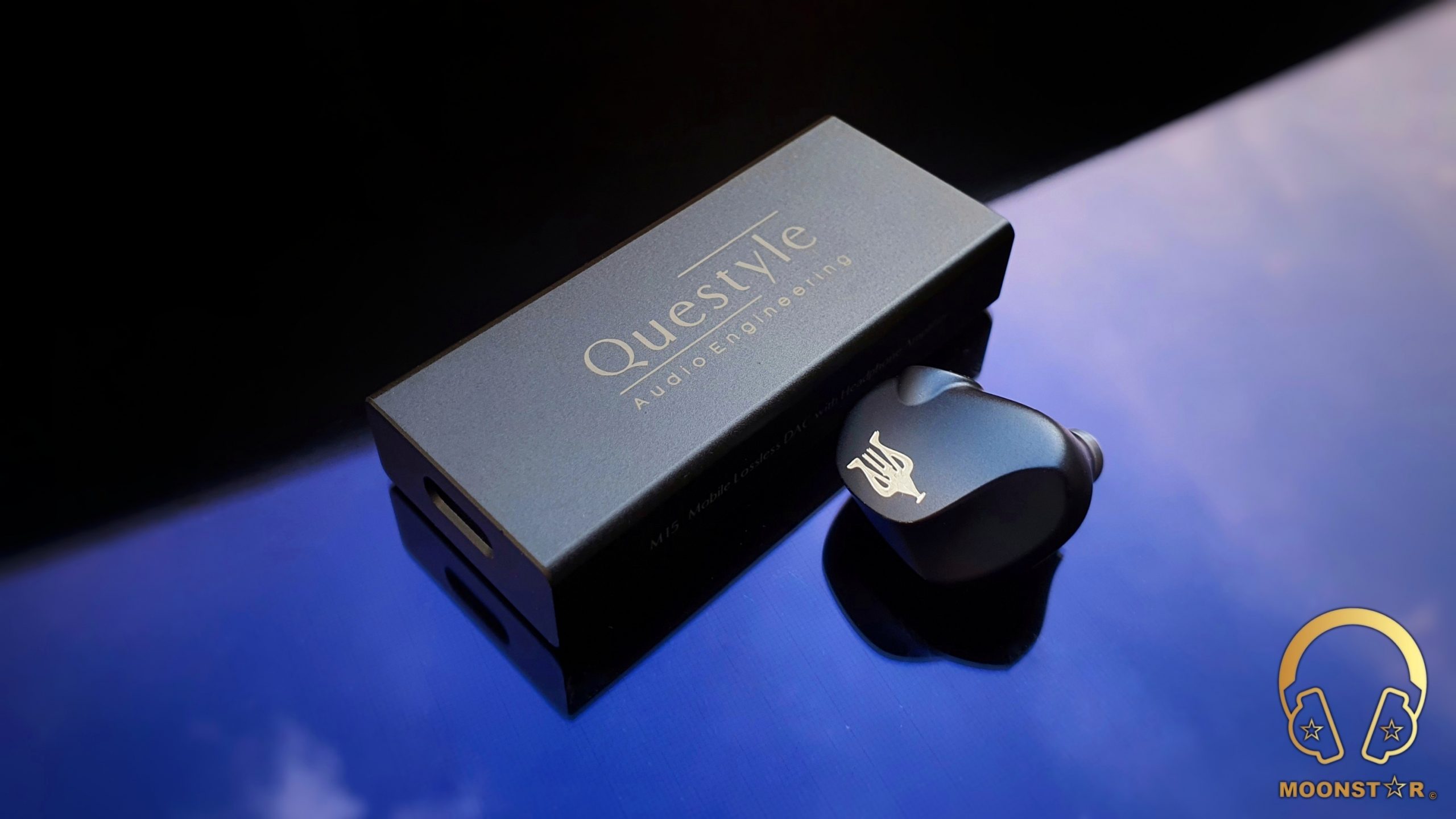
Bass:
The Questyle M15 offers a very natural and balanced bass response along with a decent grade of technical performance. The general bass character of the M15 can be described as highly controlled and quite detailed, from the subbass up to the midbass area.
The subbass region of the M15 reaches pretty low and offers a good sense of rumble and control paired with IEM’s like the Kinera URD or Meze Audio RAI Penta when I do listen to songs like Bro Safari, UFO’s “Drama“, Lorde’s “Royals” or Massive Attack’s “Angel”.
The midbass region is one of the highlights of this ultra-portable DAC/Amplifier that is reproduced with great sense of impact, clarity and authority when I do listen to complex passages Charly Antolini’s “Duwadjuwandadu” or Gogo Penguin’s “Raven”.
Instruments from cellos to bass guitars do have a good level of weight and fullness, while snare and kick drums are represented in a pretty tight and impactful manner when I have listen to the Questyle M15 with high-end In-Ear Monitors like the Campfire Audio ARA and Meze RAI Penta.
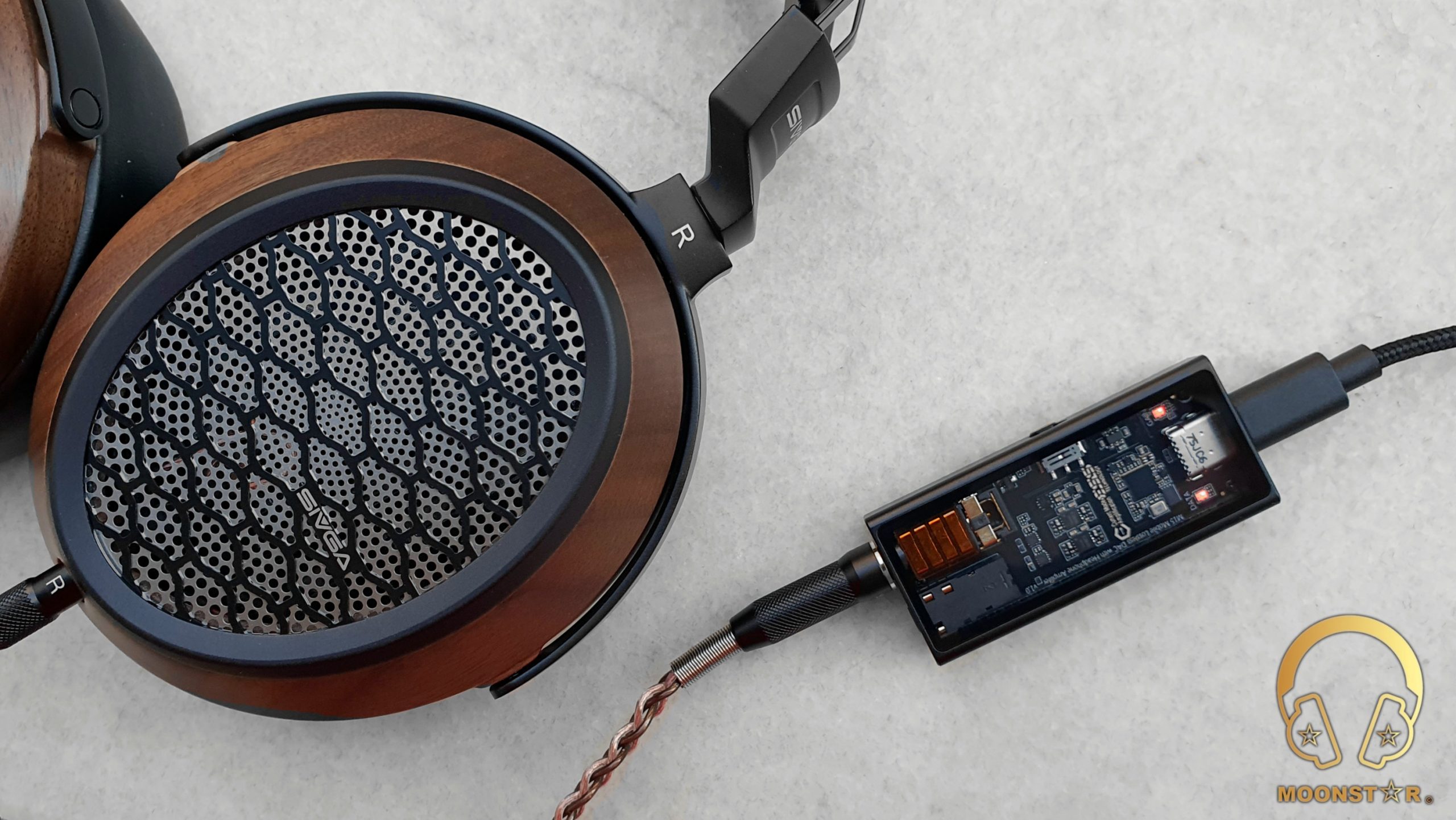
Midrange:
The Questyle M15 shows a very natural, liquid and highly transparent midrange presentation with decent sense of airiness and headroom for instruments and vocals. The general tonality of the midrange is a tad warmer than neutral and pretty organic, which is one of the highlights of this small USB DAC/Amplifier.
The lower midrange of the Questyle M15 offers a pretty good sense of body and depth when I do listen to male vocals like Barry White, Elton John, Dave Gahan or David Bowie or to instruments like acoustic guitars, violas or trumpets. The upper midrange region is another highlight of the Questyle M15 that is reproduced in a quite detailed, dynamic yet controlled manner. Female vocals from Adel to Sarah McLachlan, Edith Piaf to Randy Crawford do sound lively, fluid and emotional, especially when I pair it with IEM’s like the Kinera URD, Meze Audio RAI Penta and HiFiMAN Edition XS headphone.
Instruments on the other hand do have a pretty natural timbre and are shown in highly detailed and well extending manner that surpassed my expectation from such a small and well-priced product. What also surprised me was the sense authority when I have listen to guitar solos with high level of distortion such like Megadeth’s “Sweating Bullets”, Slayer’s “Angel of Deaths” or to Rush’s “Leave That Thing Alone”.

Treble:
The treble range of the Questyle M15 is fluid, highly controlled and detailed. It offers a decent sense of presence and brilliance when I do listen to instruments and soprano voices. The transitions in moment when instruments do play with high level of distortion are reproduced in a quite controlled manner with all IEM’s and headphones that I have listen to it, which is quite surprising for a devices that is equipped with a ESS Sabre DAC. This shows how well the sound engineers have implemented an ESS Saber DAC that sounds both detailed yet controlled in this area.
The lower treble range of the M15 adds to the overall presentation a decent level of clarity, while the extension is pretty successful while listen to instruments like snare drums or cymbals and soprano voices like Sertap Erener and Sonya Yoncheva.
The upper treble region is able to produce a pretty good level of airiness and sparkle when I do listen to instruments such like pianos, hi-hats or cymbals, especially when paired with the Campfire Audio ARA, SIVGA P-II and HiFiMAN Editions XS.
The overall control, extension and detail retrieval of the Questyle M15 is simply stunning, while the intensity and quantity in this area is not too much or too low, which makes it to a very versatile source.

Soundstage & Imaging:
The Questyle M15 has a fairly spacious and airy soundstage atmosphere that is suitable for a precise placement and separation of instruments and vocals. The soundstage of the M15 shows an efficient level of depth and wideness that is not spectacular but sufficient for such an Ultra-Portable USB DAC/Amplifier device.
Comparisons:
Questyle M15 versus Cayin RU6:
The Cayin RU6 is one of the popular Ultra-Portable USB DAC/Amplifiers on the market that gained attention with its discrete R-2R DAC circuit design and powerful output capabilities for its size.
When it comes to the build quality, I can say that both products do offer a premium look and feel. The Cayin RU6 is slightly thicker and longer with dimension of 65×25.4×13.7mm, while the Questyle M15 is a bit slimmer and a bit wider with about 61.8×27.2x12mm. The RU6 has a small OLED screen that gives information about the sampling rate, volume, etc. and comes with physical hardware buttons that are dedicated for volume and mode selection. The M15 on the other hand has no screen or buttons for volume control, but comes with LED light indicators that do give information’s about the sampling and gain status, and is also equipped with a Low/High gain switch that the RU6 not has.
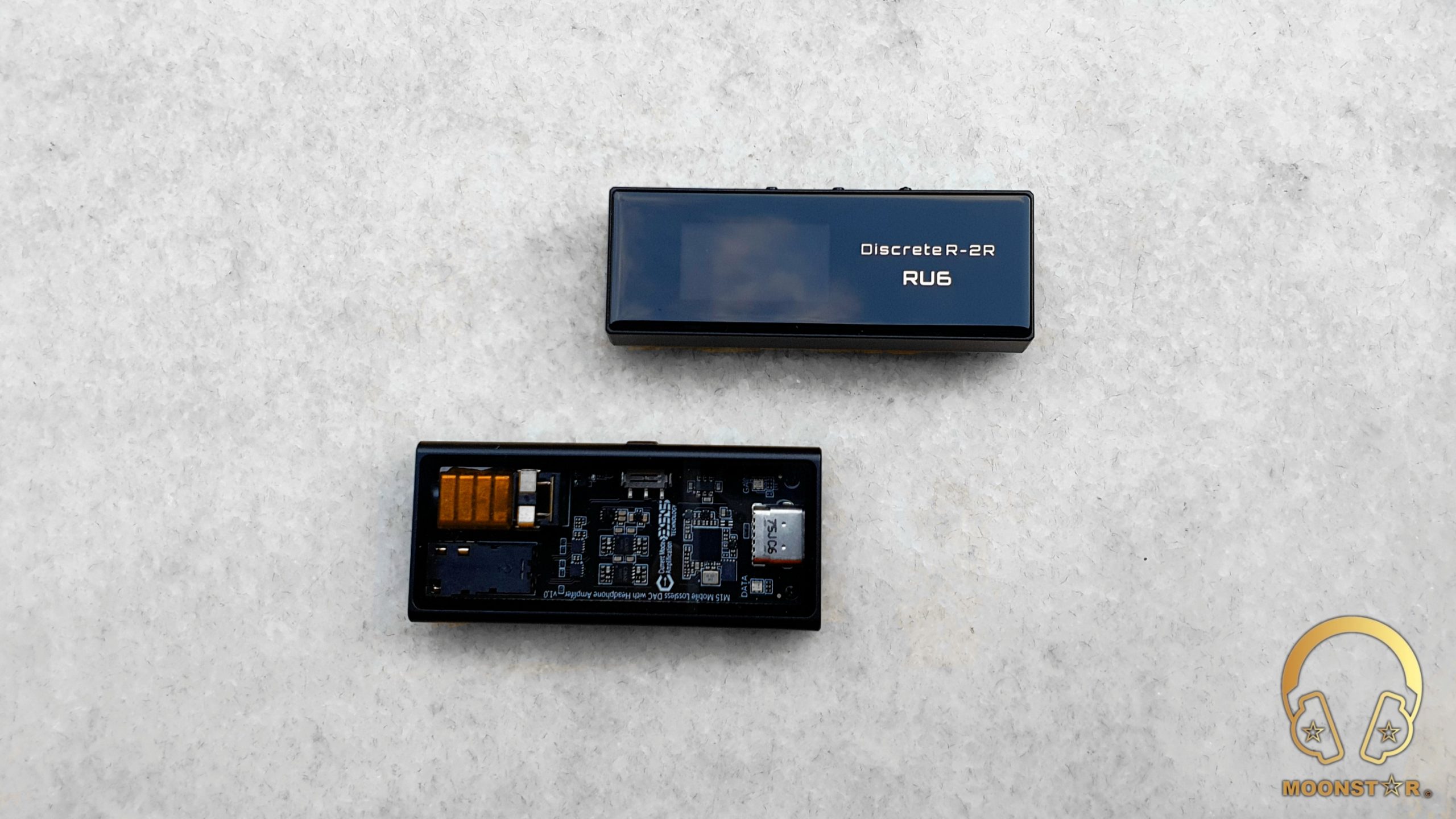
Both devices do offer both 4.4mm Balanced and 3.5mm Single ended outputs. The Cayin RU6 is equipped with its own 24-bit R-2R DAC design, while the Questyle M15 features the ESS ES9281AC DAC Chip. Both are capable to decode Native DSD up to DSD256 and PCM 24 bit/384kHz, while the M15 supports also MQA. The RU6 and the M15 are able to driver full sized open-back planar headphones such like the SIVGA P-II or HiFiMAN Sundara/Edition XS, while the Questyle M15 seems to be even more powerful than the Cayin RU6 especially on high gain. What I don’t like about the analog outputs of the RU6 is that there is an audible background noise, while the M15 is death silent. The EMI shielding of the RU6 seems not to be the best, since it has picks up some interference from my Samsung Galaxy Note 10 Plus, when I put them side by side.
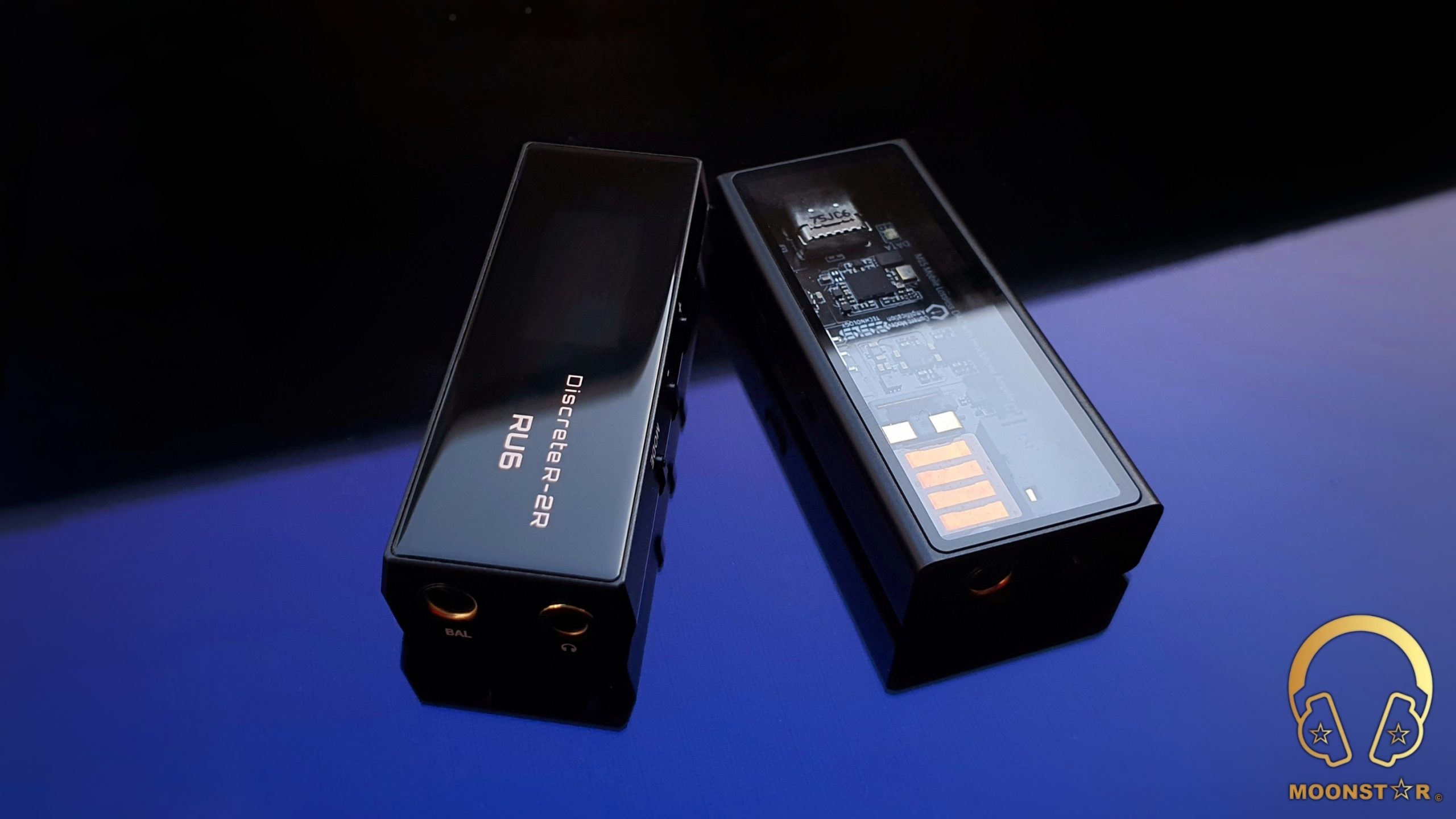
As for the sound, I can say that both devices offer different flavours that can be preferred to each other. The Cayin RU6 shows a slightly warmer tonality that is close to the classical analog sound signature, while the difference is not very high. The Questyle M15 seems to be slightly more neutral in tonality, but has also a pretty organic timbre.
Both the subbass and the midbass region of the Cayin RU6 do show slightly more depth and intensity compared to those of the Questyle M15. However, the M15 has the upper hand in terms when it comes to the clarity, resolution and sense of authority in the lower frequency register.
The midrange of the Cayin RU6 has a pretty warm tonality and highly musical character that I really enjoy. The Questyle M15 on the other hand shows a slightly more natural, neutral and somewhat organic timbre when I do listen to both vocals and instruments. The M15 offers a higher sense of transparency and airiness in this area. The lower midrange of the RU6 shows a bit more body and depth, while the M15 has the slightly edge when it comes to the clarity and resolution in this register.
The upper midrange and the treble region of the Questyle M15 sounds slightly more highlighted and energetic/dynamic compared to those of the Cayin RU6, without to be overly sharp or sibilant. The treble region of both devices sounds in general pretty controlled, while the M15 has the slightly edge when it comes to the level of resolution, extension and separation that was quite audible when I do listen to instruments like cymbals or hi-hats.
The soundstage of both the Cayin RU6 and the Questyle M15 shows an efficient level of depth and wideness, while the M15 has the slightly edge when it comes to the depth and airiness of the stage. Another advantage of the M15 is its pitch black background that makes it easier to hear micro details.
Questyle M15 versus Shanling UA5:
The Shanling UA5 is the company’s new flagship USB DAC/Amplifier that I have reviewed recently. It is equipped with a build-in Lithium Battery that is part of its “Hybrid Power Mode” to reduce the power consumption of the source and to give the components a stabile energy source in order to increase the sound performance.
Both the Shanling UA5 is a premium looking device with a high build quality same like the Questyle M15. The UA5 is relative longer and thicker with dimension of 68x27x13.5mm (versus 61.8×27.2x12mm) while both are equal in terms of wideness. The UA5 comes with a small OLED screen that gives information about the gain mode, volume and sampling rate. Moreover it has a multifunctional wheel for volume adjustment and navigation that the M15 not has.
The UA5 is a pretty powerful device that offers both 4.4mm Balanced and 3.5mm Single Ended outputs like the M15. However the M15 is again more powerful compared to the UA5, especially at high gain, while both devices do offer a quite similar in terms of background noise performance, which is a tad cleaner on the M15. The Shanling UA5 is equipped with 2x ESS Sabre ES9038Q2M DAC chips, which do offer PCM decoding up to 32 Bit/768kHz & Native DSD up to DSD512, while the PCM and Native DSD decoding of the Questyle M15 is limited with PCM 32bit/384kHz and DSD256.
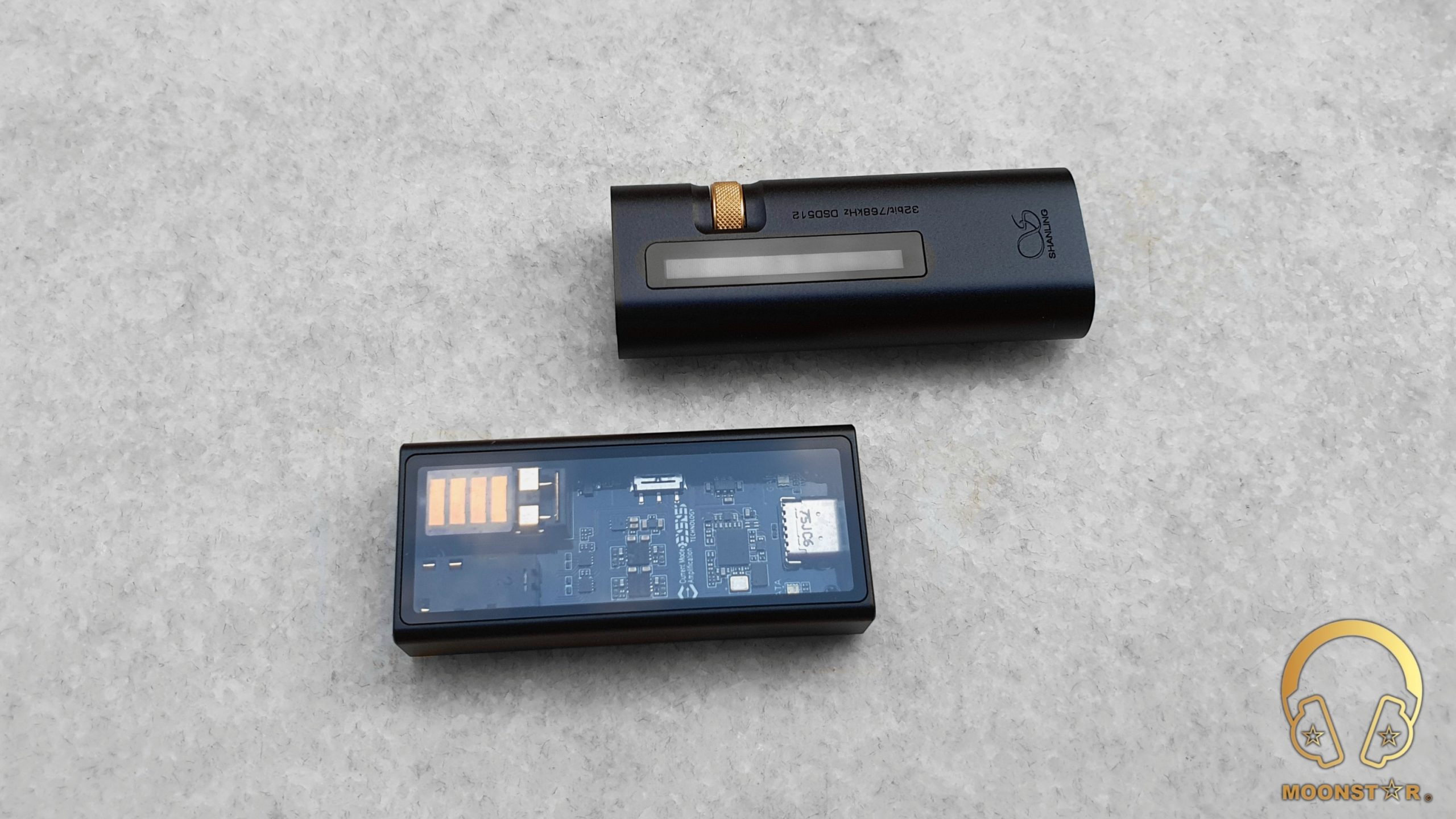
The Shanling UA5 shows a slightly brighter tonality and more energetic overall sound signature, while the Questyle M15 shows tad more neutral tonality and more balanced presentation from the lows to the highs.
The lower frequency region of the M15 sounds more dynamic, fast and has also the upper hand when comes to authority in complex bass passages such like Gogo Penguin’s “Raven” or Charly Antolini’s “Duwadjuwandadu”. Both devices do offer a clean and detailed sub- & midbass presentation, while the M15 is the source with the more fluid and natural character in this area.
The midrange of the Shanling UA5 shows a slightly brighter tonality and a more energetic overall presentation, while Questyle has managed do create a more organic and liquid midrange character from an ESS DAC chip. Both the UA5 and the M15 do offer a pretty transparent and airy midrange atmosphere with decent level dynamics and resolutions that can compete with full sized Android DAP’s with double or even triple the price. The lower midrange of the Questyle M15 shows a bit more body that was audible when I have listen to acoustic guitars and violas, while both do offer a fairly similar performance in terms of resolution in this area.
The upper midrange of the Shanling UA5 is slightly more highlighted yet a bit dry and sharp when I do listen to female voices or to instruments like clarinets, violins or pianos. The Questyle M15 on the other hand sounds pretty controlled and natural in this area, which makes is more compatible with different earphones/headphones and enjoyable for longer listening periods.
The treble range of the Shanling UA5 is slightly more pronounced and energetic compared to those of the Questyle M15 that shows a more balanced and natural presentation in this area. The lower treble region of both devices is detailed, extends pretty well and offers a decent sense of clarity and definition. The upper treble register of the Shanling UA5 is a bit more highlighted and detailed, while the M15 offers a higher level of authority and separation.
The soundstage of the Shanling UA5 is slightly more expansive, while the Questyle M15 shows a better performance when it comes to the depth of the stage.
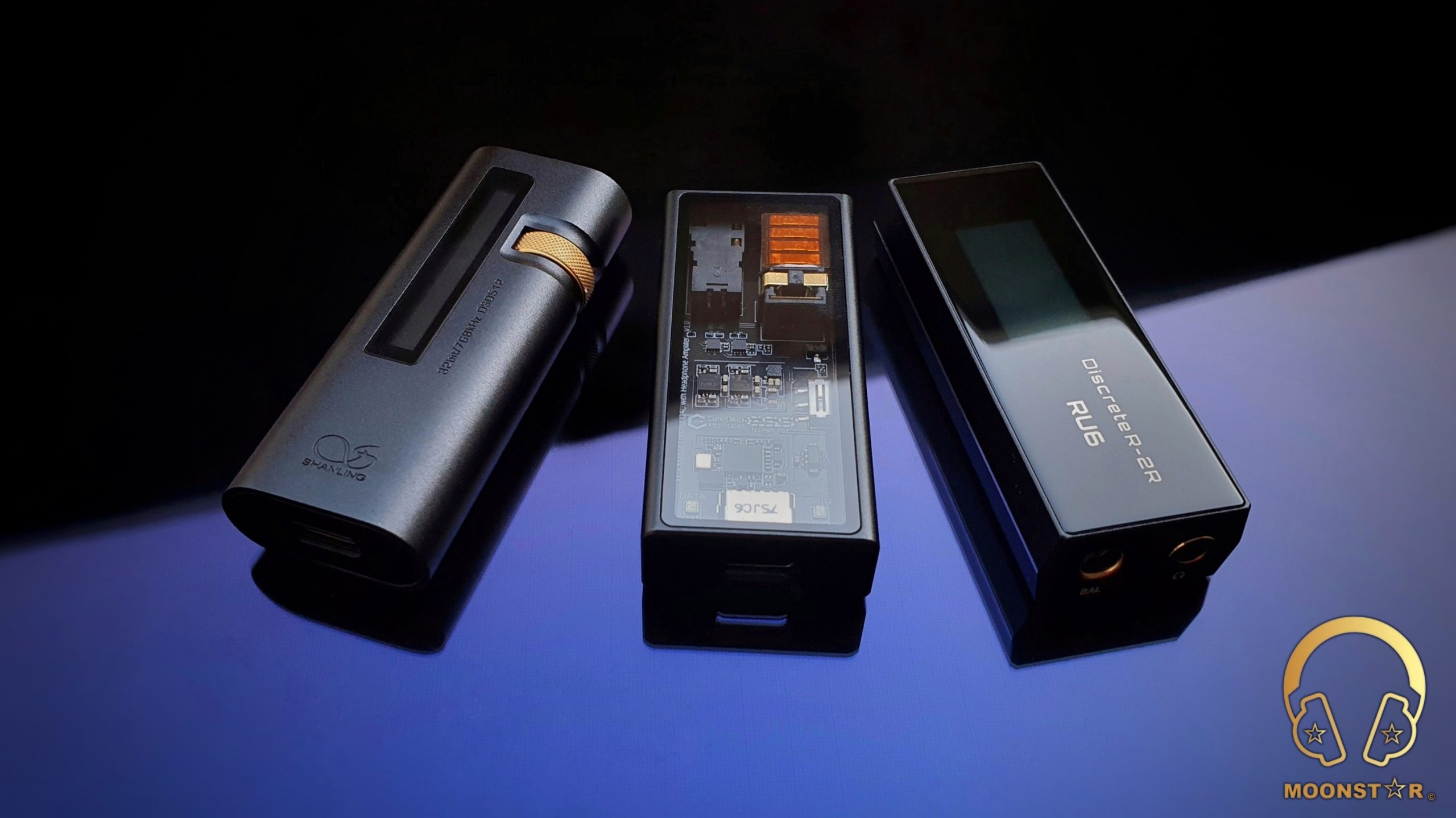
Conclusion:
I have tested many Ultra-Portable USB DAC/Amplifiers so that I can easily say that the Questyle M15 is one of the best available on the market. It immediately impressed me with its unique design, premium appearance and with its very natural, highly detailed and mature sound presentation. Moreover, it comes with both 4.4mm Balanced and 3.5mm Single Ended outputs that do offer plenty of power for demanding headphones and an ultra-clean background for sensitive In-Ear Monitors. All this features are packed in to a small device that can compete with full sized DAP’s that do cost twice or even triple the price that M15 has.
Thank you for the Read!
View previous replies…
Moonstar
@klaus2325 You are welcome 
Pirastro
Wow yet another reviewer working for Questyle. These reviews are starting to make me ill.
OspreyAndy
500+ Head-Fier
Pros: -
- Superbly well balanced neutral and natural sound
- Reference grade technical prowess
- Amazing driving power
- Highly versatile and adaptable to any partners
- Native iOS support
- Superbly well balanced neutral and natural sound
- Reference grade technical prowess
- Amazing driving power
- Highly versatile and adaptable to any partners
- Native iOS support
Cons: -
- I wish there was an independent volume adjuster
- Slightly larger in size compared to competitors
- I wish there was an independent volume adjuster
- Slightly larger in size compared to competitors
Questyle M15
Review Date: 30 April 2022
SPECIFICATIONS
Quad amplification engines
Flagship-grade ESS Sabre ES9281AC
Dual Headphone Output Ports(3.5mm Single-Ended+4.4mm balanced)
Two-level gain switch
LED indicators for gain and active bitrate
Low power consumption TOREX power chip
Technical Specs:-
Decoding Parameters: PCM 32-Bit/384kHz, DSD256
Output Interface: 3.5mm single-ended, 4.4mm balanced
Output Power(3.5mm): 11.97mW @ 300Ω, Vout (Max): 1.895Vrms
Output Power(4.4mm): 22.60mW @ 300Ω, Vout (Max): 2.624Vrms
Frequency Response: 20Hz-20kHz±0.1dB
THD+N: 0.0003%
Dimensions: 61.8×27.2x12mm
Test Equipment
IEMs and Earbuds:
- Etymotic ER4SR (Single BA, 45 Ohm, 96db Sensitivity)
- Shure KSE1500 (Single Electrostatic 200V, KSA1200 Energizer)
- Kinera Idun Golden (3BA + 1DD Hybrid, 32 Ohm, 112db Sensitivity)
- Tripowin HBB Olina (Single DD, 32 Ohm, 110db Sensitivity)
- VE Asura 3.0 FE SLQ (Single DD, 155 Ohm)
- VE Monk GONE SPC (Single DD, 32 Ohm)
- BuduBuds V1 (Single DD, 32 Ohm)
- FOSTEX T40RP MK3 (Magnetic Planar, 50 Ohm, 91db Sensitivity)
- Beyerdynamic DT880 (Dynamic Drivers, 600 Ohm, 96db Sensitivity)
- Windows 10, Foobar 2000 (USB 3.0 Power)
- LG V50 ThinQ (UAPP USB Exclusive Mode, Bitperfect)
- Sony Xperia X Compact (UAPP USB Exclusive Mode, Bitperfect)
- HiBy Music Player App (USB Exclusive Mode)
LISTENING EQUIPMENT USED IMPARTED HUGE INFLUENCE TO SOUND IMPRESSIONS & RATING
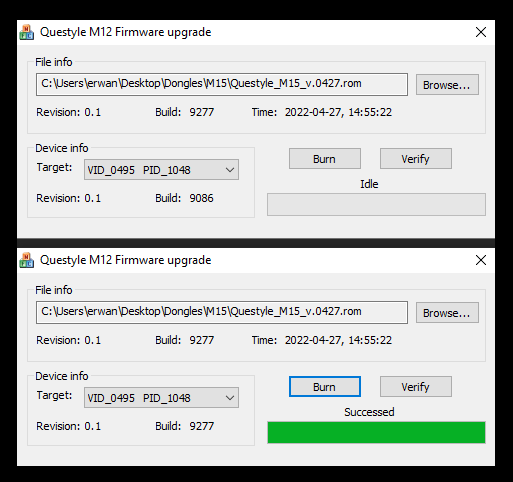
At the time of my review, my M15 has been upgraded from FW Build 9086 to Build 9277 which can be downloaded directly from Questyle here:
https://questyle-en.oss-us-west-1.aliyuncs.com/Driver/M15 Firmware_v.0427.zip
Questyle M15 marked the progression and evolution introduced with M12, the only Current Mode amplification Dongles to exist now. It is no secret that among over 120 Dongles I owned, the M12 ranks the highest in my book for ESS Sabre unit. I even prefer it more over Apogee Groove and the slew of Hidizs S9 Pro, E1DA 9038 or REIYIN DA-Plus – all of which prime examples of properly tuned ESS Sabre units.
When M15 was released, gleefully I took the opportunity head first to have it delivered to my doorsteps. Full of anticipations and excitement. I know Questyle has great tuning principle and this is a known fact among many audio enthusiasts. Let’s see how does M15 fares in the real world shall we?
PS: As noted above, my M15 has undergone a Firmware update and the entirety of my review are based on it – post FW update.
Build, Functions, Usability
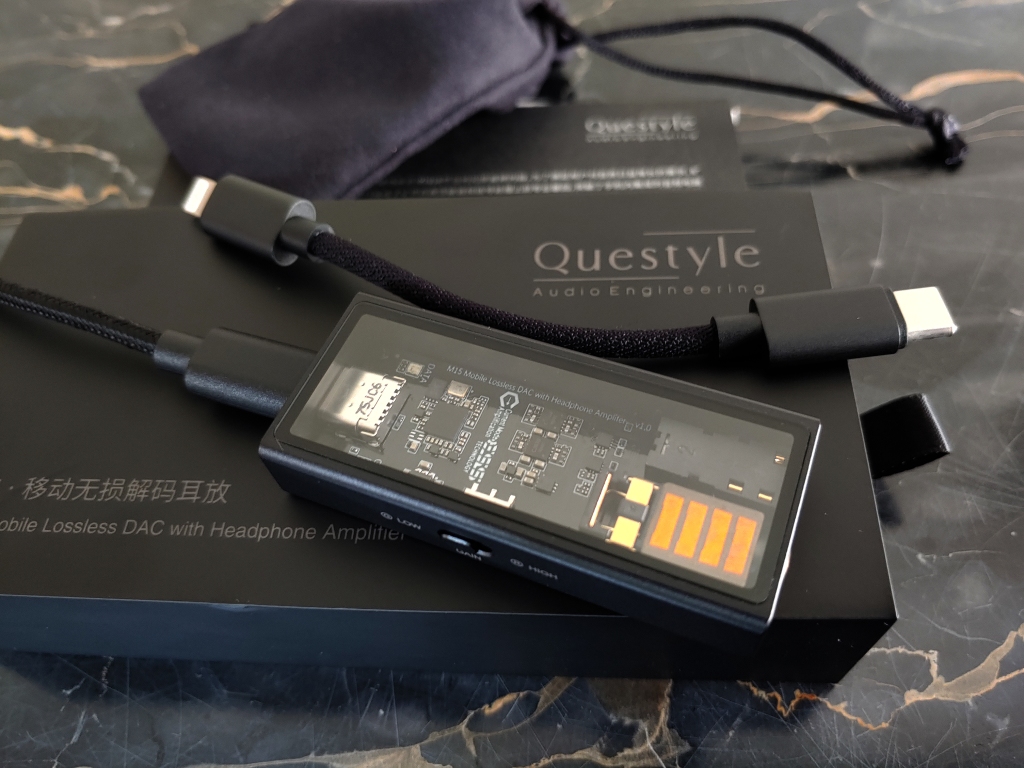
M15 is a huge Dongle, in fact I daresay it is 3x the size of M12. It is probably the 3rd largest Dongle I ever owned. Apogee Groove being the largest then followed by CEntrance DACport HD. By current standards, M15 is one hell of a solid device construction wise. The traditional rectangular design being simple as it is functional.
Most prominent feature would be the glass faceplate on one side. The glass window would allow us to savor looking at the beautifully crafted internals. Clearly showing generous real estate of components. As I said earlier, M15 is large. The rationale behind this, Questyle opted to go purist route on M15. They forgo the need to downsize in favor of innovation, to ensure that M15 will have all the bells and whistles of a top of the line performer.
Feature wise, despite the size, M15 offers equally simple stuffs like imbedded led lights that can be seen through the glass window. One for power/resolution and another one for High/Low gain. On one side, there’s user selectable hardware switch for gain selection.
However, M15 does not offer any sort of volume adjusters on the Dongle itself. I must admit that I wished it would have include some sort of independent volume adjusters. What I have learned so far, independent volume adjustment does have big role in fine tuning listening loudness. As observed with the likes of Cayin RU6, DACport HD and Lotoo PAW S2 – all of which comes with super refined volume adjusters, the ability to fine tune volume levels has help to elevate music listening greatly – at least in the manner of how I normally use the Dongles – set the volume at Max on the host and let the DAC/Amp regulate the output. Perhaps Questyle can consider this in earnest in upcoming Dongle line-ups.
As for the volume adjustment itself on the host side, like most other Dongles without independent/dedicated adjusters, M15 depends largely on the volume steps resolution of the source. So in order to have fine adjustment, it is necessary to use HiBy Music App (Software Volume Mode) or UAPP Volume Steps. But at least I can tell natively M15 does offer “less jumpy” gain between levels as observed with some other devices.
While M12 came with just 3.5mm SE, M15 stepped up to the current standards of including a 4.4mm BAL Pentaconn port. Balanced circuitry that offers discrete power each channels (L/R) instead of shared GND. This has allowed them to push the power output higher and will work great with power hungry partners.
In alignment with what was already introduced with M12, M15 also offers the latest iteration of Questyle Current Mode amplification. I honestly don’t know much about this technology, so I would not dwell too much talking on it. But what I do know, the Current Mode amp stage of both M12 and M15 plays huge role in shaping up the sonic characteristics they offer.
As with most other Dongles nowadays, M15 comes with female USB C interface for the data link. This will allow for swapping of cables to suit the needs. Included in the stock package, M15 comes with both USB C and iOS Lightning cables. This effectively means that M15 is among the few that has been designed and built from scratch with versatile compatibility to iOS.
Despite being a “larger than normal” Dongle, M15 appeared to be adequately efficient with power draw to the host. With my Sony Xperia X Compact (Android 8, 2700 mAH Battery), M15 was able to clock 5-6 hours of continuous play – driving Tripowin Olina at low gain, USB Exclusive mode UAPP. This is pretty much on par to the competitions like Lotoo PAW S2 and Cayin RU6. Only xDuoo Link2 BAL and HiBy FC5 scored better at almost 7 hours.
Most impressive, M15 is probably the best Dongle DAC/Amp with heat management. Despite the larger size, M15 was able to stay relatively cool even on prolonged sessions.
Sound Impressions

Questyle M15 is a wonderfully balanced DAC/Amp. From the moment I plugged it in with my Etymotic ER4SR, I was already mesmerized with fluid, crisp, smooth and highly resolving output that does not exhibit any coloration in any frequencies. It is admirably organic and refined sounding. Despite being an ESS Sabre based DAC, there’s absolutely no hint of Pinna Glare or unnatural edgy brightness that is notoriously evident with most ESS devices. The signature of Questyle tuning, it is super clean with immaculate resolved notes and tones – while at the same time managed to avoid the pitfalls of sounding sterile and dry. If I am to turn back the clock over a year ago, when I first tried the older M12, I remember the output was already amazingly clean and pristine – however I did mentioned that M12 (with the old Firmware) has some tendency to emit some dryness. Questyle fixed that for good with M12 later version FW. What I am hearing now from M15, an evolution of that immaculate sound. Something that is exceedingly technical yet musical.
Perhaps if I am to nitpick, on a very personal level I normally prefer a bit more of analogue touch to the output, M15 seems to be not as analogue sounding when compared to CEntrance DACport HD, Ovidius B1 or Cayin RU6. M15 is more aligned with the Hi-Fi sound approach which is favored by L&P W2, HiBy FC5, Colorfly CDA M1 and REIYIN DA-Plus – which means among them all, I can easily say that M15 is the BEST of the crop with that Hi-Fi approach. That effortless dynamics and transients making it such a pleasure to listen to, the overall theme being crispy smooth, resolving and detailed.
On dynamic range, M15 is assuredly a stellar performer. The extensions on both ends nothing short of impressive. What I am hearing from my regular favorites of Shure KSE1500, Etymotic ER4SR and Fostex T40RP MK3 revealed how rich the extensions are. Highly detailed on macro and micro levels. Sub Bass being rich and dense, Treble being sparkly with proper texture, Mids being wholesome and engaging – and keeping it neutral, uncolored while at it. Never a moment I felt that any of the frequency range being emphasized beyond what is realistic.
Technically, M15 is an absolute beast. Just like the predecessor of M12, M15 carried on with that trajectory with some of the very best technical performances I have heard so far. Being critical, perhaps the only caveat that I can point out would be the average sized soundstage which I wished could be a bit wider. In this regard, I would say that the likes of xDuoo Link2 BAL, THX Onyx and DACport HD offers the widest soundstage still. M15 on the other hand is pretty much similar to Cayin RU6 and Lotoo PAW S2, it has breadth of space, depth respectfully spacious but just slightly short on absolute width.
What M15 does offer in spades, reference level of resolution, imaging, speed, details and separation. M15 is a device that will please even the most demanding need for technical indulgence for listening to highly complex music. The better the recording and mastering, the better it gets. For example, with highly complex Jazz composition, I was able to appreciate even the most subtle of nuances – presented with crisp imaging and cleanly defined layers. In fact M15 performed miracles with my favorite duo of Kinera Idun Golden and Tripowin Olina – elevating those two IEMs technically to TOTL level of performances, no joke!.
As I always mentioned, the hallmark of a great DAC/Amp – their ability to synergize with anything. And M15 is one such devices. Be it my super hard to drive Beyerdynamic DT880 600 Ohm and Fostex T40RP MK3, open back VE/BuduBuds earbuds, highly sensitive hybrid IEMs, even legitimate 200v Electrostatic of Shure KSE1500, M15 does it all with such guile and finesse. That’s how a true neutral DAC/Amp should behave – it does not show any specific preferences to what sound curves the paired partners have. It just works
Driving Power
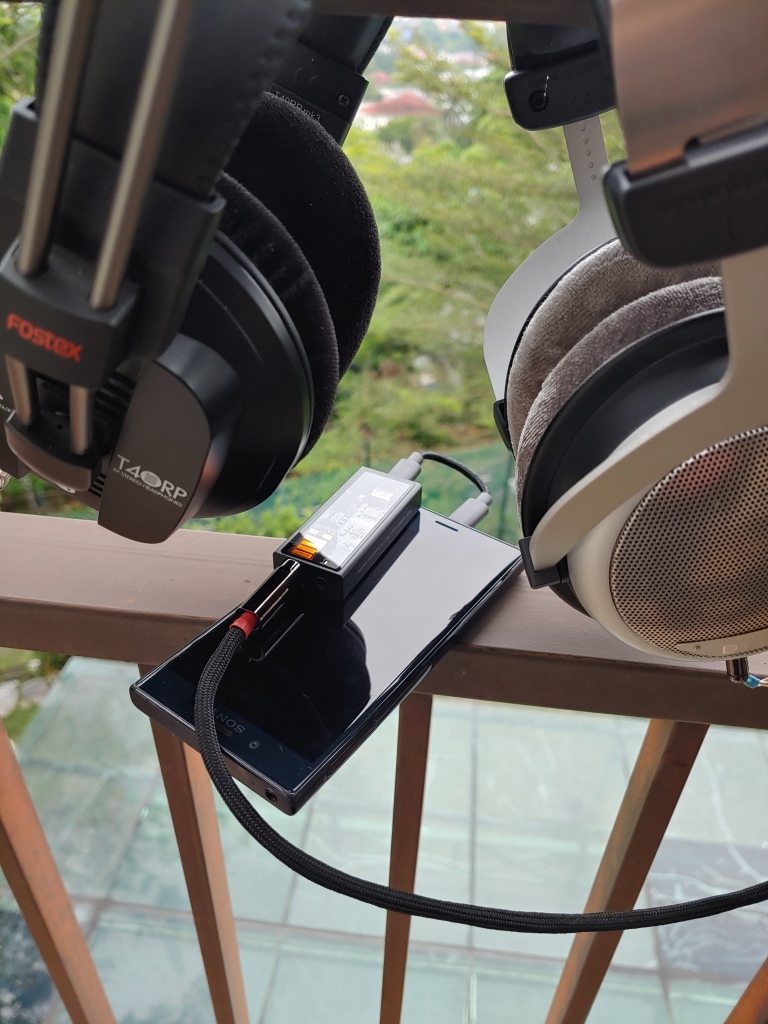
Questyle M15 is a 2.62 Vrms rated dongle (4.4mm BAL). Despite not being a 4 Vrms device, M15 does have tons of power at its disposal. This is similar to the performances of Ovidius B1, Hidizs S9 Pro and Creative SXFi, the other 2 Vrms devices that offer tons of power to even handle super stubborn magnetic planars.
For my own usage, M15 performed spectacularly to drive Beyerdynamic DT880 600 Ohm with ease. On HiBy Music App USB Exclusive mode, M15 only needed 16/32 volume for proper listening loudness. On my PC it was at 40/100 max (any higher and it would be just too loud for my comfort). Simply put, the sort of performance offered by M15 in this scenario really cemented my belief that I don’t need a dedicated desktop DAC/Amp stack combo. Everything about the sound simply being wholesome and satisfying. No hint of micro jitters or distortion. It’s all about fluid harmonics end to end. I am not hearing any loss of micro details. About the only thing missing, perhaps absolute headroom sense, like 2% less headroom as compare to the output as heard from my iFi ZEN Stack of ZEN DAC V2 + ZEN Can. That 2% is totally negligible. The same can be said for the magnetic planar of Fostex T40RP MK3, one of the most stubborn planar headphones out there now – no sweat for M15.
On the other hand, despite all that power, M15 has also shown amazing synergy with super sensitive and easy to drive stuffs. I am getting super clean output from my Tripowin Olina and Kinera Idun Golden. Pitch black background even on the most silent of passages. This is consistent even on High Gain mode.
Volume Difference (With Etymotic ER4SR, HiBy Music App, USB Exclusive Mode)
SE 3.5mm = 12/32 (Low Gain)
BAL 4.4mm = 9/32 (Low Gain)
I am happy that both 3.5mm and 4.4mm ports shared identical sound quality. The difference only the absolute limit 4.4mm can go which is up to 600 Ohms. However for anything under 155 Ohm the 3.5mm will work as great as the 4.4mm side. Once volume loudness matched, I can’t hear any difference at all. This is simply amazing because I have heard many (if not all) Dongles being slightly inferior on the 3.5mm side, but M15 does not neglect this element. In comparison, the likes of Luxury & Precision W2 and Lotoo PAW S1 practically treated the 3.5mm port like a 2nd class subject.
VERDICT
Questyle M15. All things considered, I am confident that M15 being one of the very few releases for 2022 that can claim 5 stars rating. Sound wise, M15 offered practically everything that I like about sonic performances. The balance of neutral organic timbre, totally uncolored and devoid of any unpleasant edginess commonly associated with ESS Sabre DACs.M15 biggest strength being superbly versatile and effortlessly fluid in projecting Hi-Fi sound in a compact form factor. Yes it is 3x bigger than M12, but the size is well justified for a truly complete package when it comes to delivering sound quality. If I must be critical, then my only wish list would be an independent volume adjuster – had that been included, M15 would have assuredly been perfect.
Simply put, Questyle M15 has set a very high standard for how a great modern Dongle DAC/Amp should sound. It is amazingly well crafted to be competently technical as it is musical. Mesmerizing every time I listen to it.

Best Pairing: Anything up to 600 Ohms
#donglemadness
Last edited:
D
DrFever
Hello @OspreyAndy, would you recommend M15 or S2 to be a better pairing with Sennheiser IE600.
On another note, I would like to confess that I am a big fan of your Dongle rankings and consider you to be the crinacle of dongle DACs.
Really appreciate your work
On another note, I would like to confess that I am a big fan of your Dongle rankings and consider you to be the crinacle of dongle DACs.
Really appreciate your work

OspreyAndy
@DrFever Thanks!. For IE600 it will synergize better with M15 especially if you prefer precision and technicalities. But if you want a bit more of velvety smoothness then S2, yeah I know I am not really helping here lol. But then I love both of them for their native attributes
Quokka
WARNING: After reading this review I ordered a Questyle M15 Dac and the Protective Leather Cover (grey) directly from the Questyle website. Last week my package arrived but was missing the Protective Leather Cover (US$25). I have since sent them several emails advising them of the missing cover and requested one to be sent. It appears all of my emails have been ignored so far as I have not had any reply from Questyle. I’m very disappointed by the lack of communication and poor customer service from Questyle


